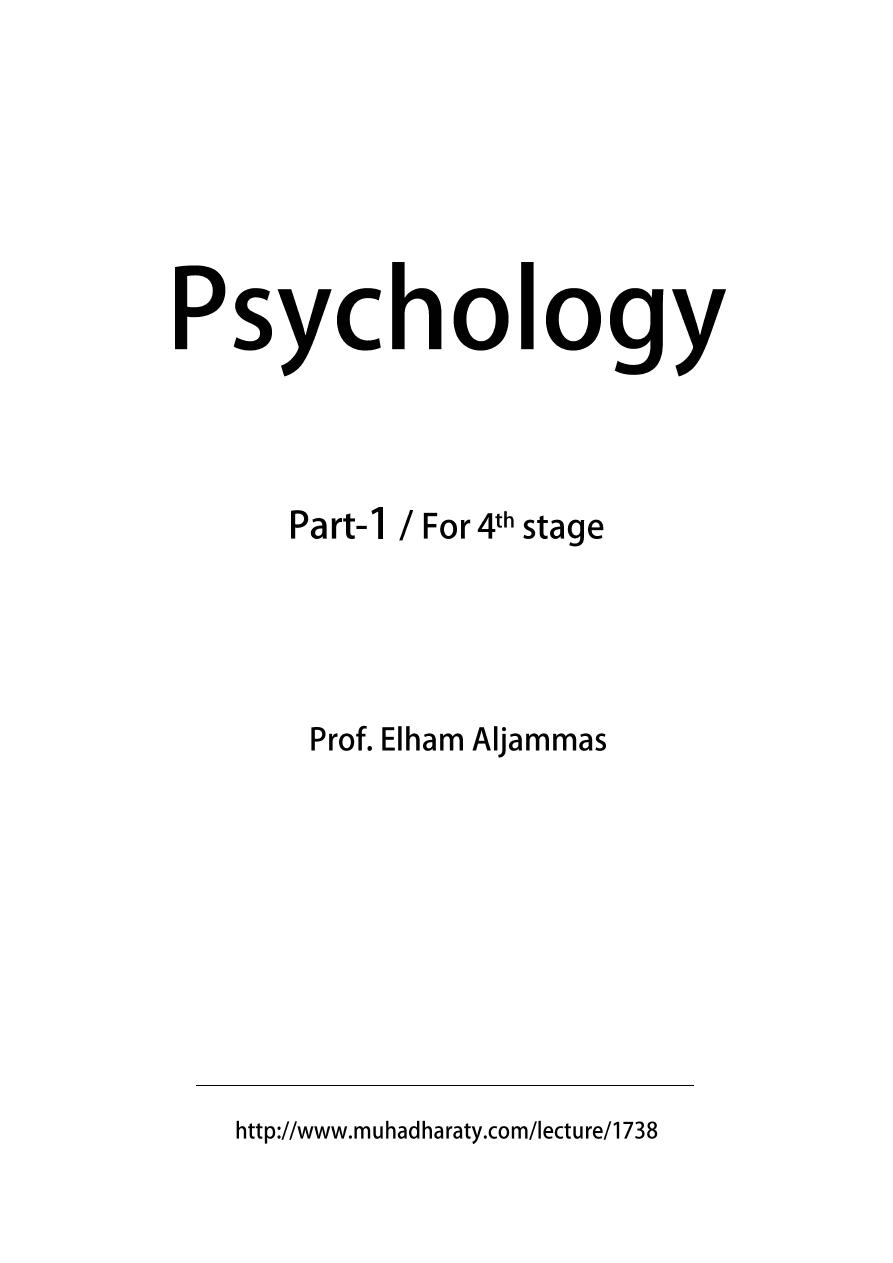
1
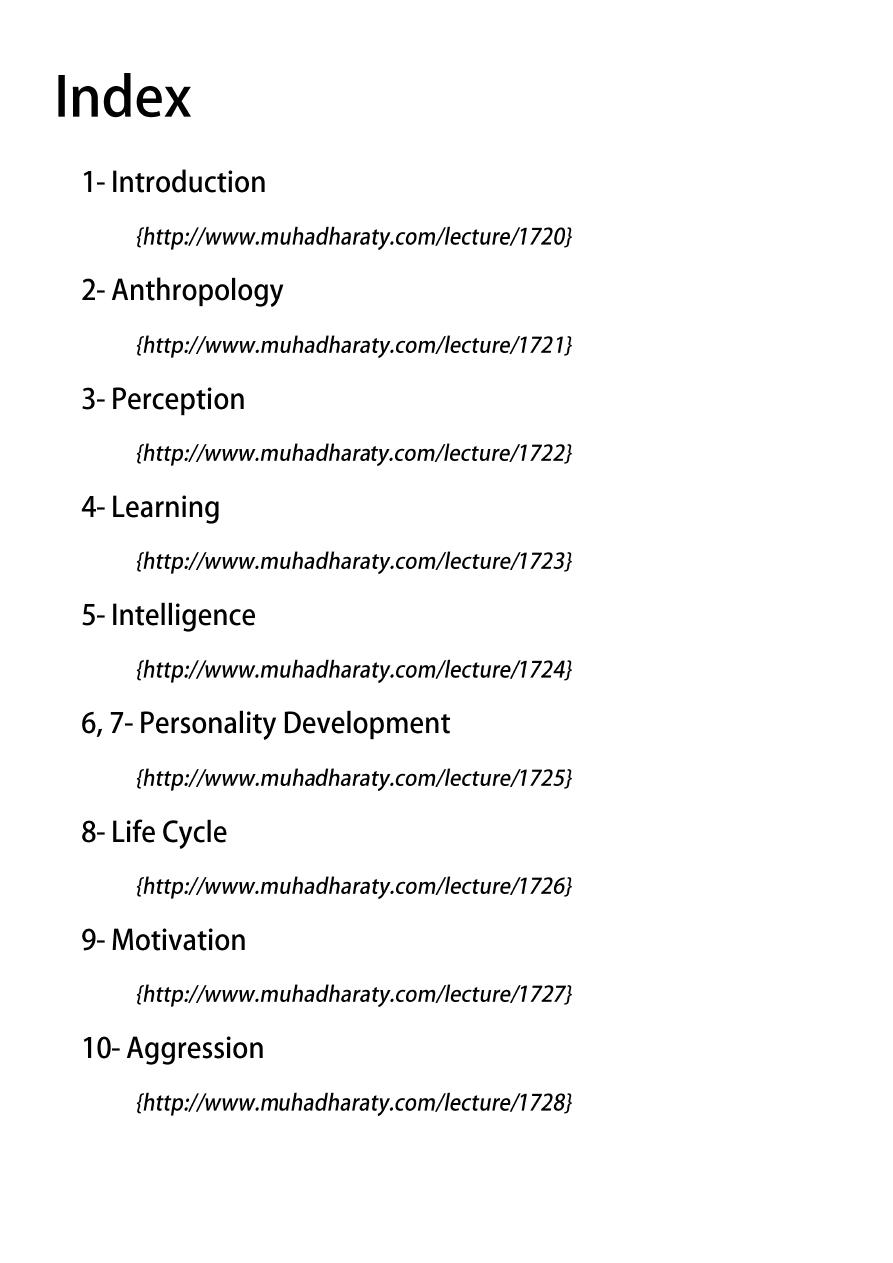
2
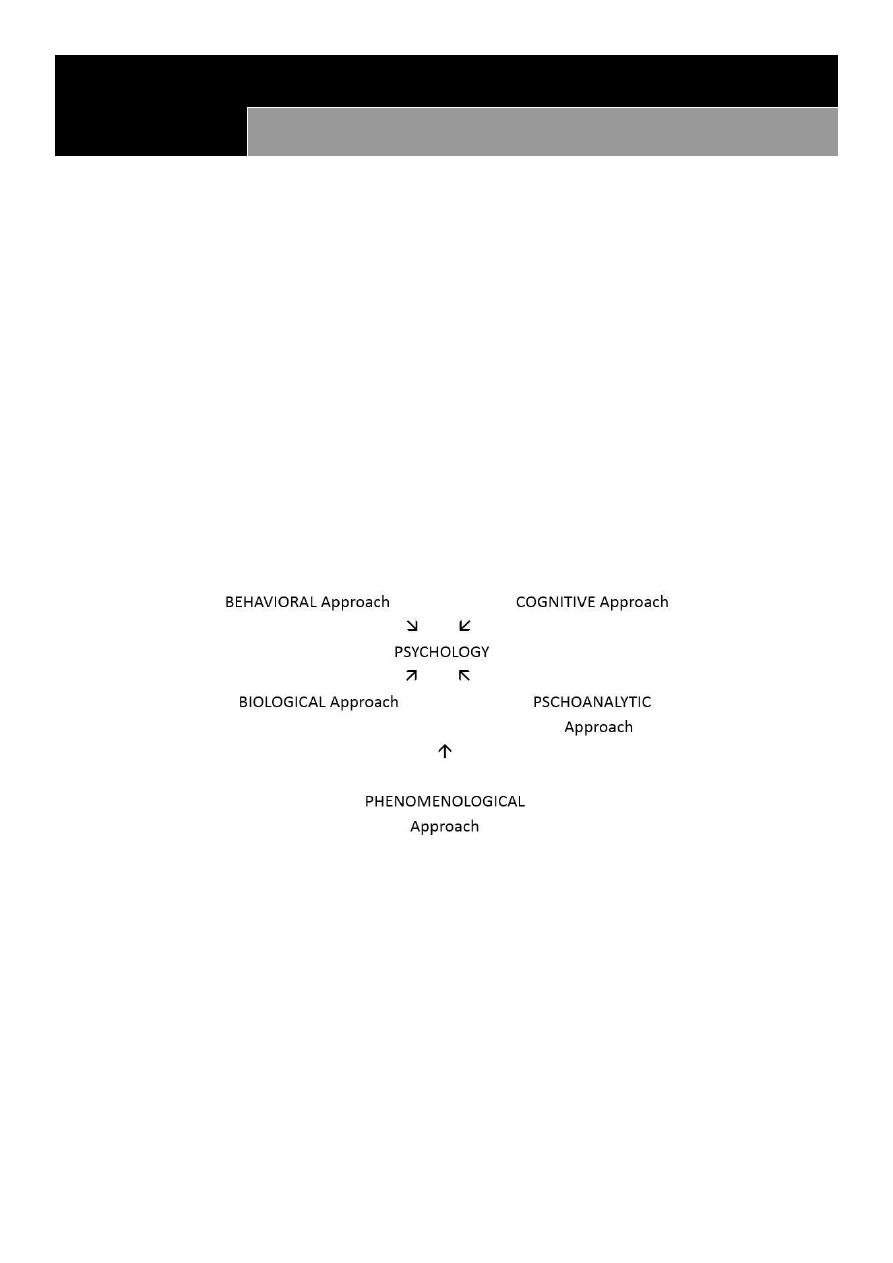
3
Lec:1
Psychology
Introduction
Objectives
1. To understand the meaning of psychology & its correlation to different factors.
2. To differentiate between normality & Abnormality
3. To determine the criteria that differentiate normality from abnormality
Definition:
Psychology is defined as the scientific study of behavior & mental processes.
Parts:
The nature of psychology
Psychological development
Sensory processes
Perception
Consciousness
Learning and conditioning
Emotion

4
Criteria to distinguish normal & abnormality behavior:
Definitions:
1. Statistical Definition Abnormal=away from normal (e.g.) Height, Weight & intelligence
2. Social Definition Abnormal = Deviation from social norms or acceptable behavior.
3. Maladaptiveness of behavior: How the behavior affect the wellbeing of the individual
or of the social group (e.g.) alcoholic, violence …etc.
4. Personal Distress Individual subjective feelings of distress rather than the individual's
behavior (e.g.) mental illness.
Normality:
Difficult to define.
The following qualities indicate emotional wellbeing.
1. Efficient perception of realty.
2. An ability to exercise voluntary control over behavior.
3. Self-esteem & acceptance (i.e.) appreciate their own self-worth & feel accepted by those
around them.
4. An ability to form affectionate relationship (i.e.) form a close & satisfying relationship
with people.
5. Productivity. Lack or excess
Classifying abnormal behavior:
1. DSM1V diagnostic statistical manual
2. ICD10 international classification of diseases (mental) no.10
Important: all
Important: short assay
Note:
Psychology normal (physiology)
Psychiatric abnormal (pathology)
Important: all

5
Lec:2
Psychology
Anthropology
Definition:
Anthropology is a social science that studies the origin and social relationship of human
being.
Psychosocial growth:
The effect of early life experience on adult mental health and exploration for deviance or
maladaptive behavior are still controversial issues.
Bowlby – stated that capable of forming attachments and of other experience later in
life were favorable.
Similary many successful adults come from deprived homes and appear to be weak to
the stressors.
Through many studies found that the effect of family relationships on personality and
mental ability appear to be minimal.
Identical twins reared together are routinely found to be no more similar in personality
than identical twin reared in separate families, sometime the separated reared twins are
found to be more similar.
Children in different families differ in personality the difference can be explained almost
entirely by their genetic differences.
The differences between non identical twin siblings cannot explained by their genetic
differences alone, as e.g. birth order.
Human behavior that do not vary cross-culture such as smiling, walking.
Race and Ethnicity:
Race: denote human grouping that are biologically determined, some character of a
given racial group e.g. skin color.
Ethnicity: Denote a group of individual sharing a sense of common identity, shared
believes and history.
In the modern era cultures and subcultures changes at increasing rates in response to
the adaptive demandes represented by the world in increasing economic, political and
social competition, this add more stresses on individual and cultural group.

6
Social factors influencing mental health:
Environmental factors
1. Poverty
2. Racial discrimination
3. Poor housing
4. Poor health care
The influences of culture include:
Patient illness behavior.
The content of delusions and hallucinations.
Attitude of family and community.
Idea regarding the recognition and etiology of illness.
Treatment required.
Culture and psychiatric diagnosis:
A particular religious belief which is acceptable in your own culture becomes labeled as
delusion in another culture.
Distress due to interpersonal conflict (marital tension or parent –child conflict) might
be as being due to culture.
Witchcraft as attribution content or precipitant:
A person who suffers from serious accident or severe mental illness may attributed to
witchcraft.
A person may have become acutely anxious may believe that a rival has used witchcraft
against them.
A person may have experience a psychotic illness may attributed it to witchcraft.
Witchcraft may provide delusions and hallucinations.
Migration and mental illness:
Immigrants have a higher rates of mental illness than their population of origin or that of
host country, the explanation for this are:-
1. Selection –people migrate for solving their problem.
2. Stress –due to language, accommodation, employment, isolation and conflict.
Social changes
1. Unemployment
2. Migration
3. Urbanization
Important: all
Important: all
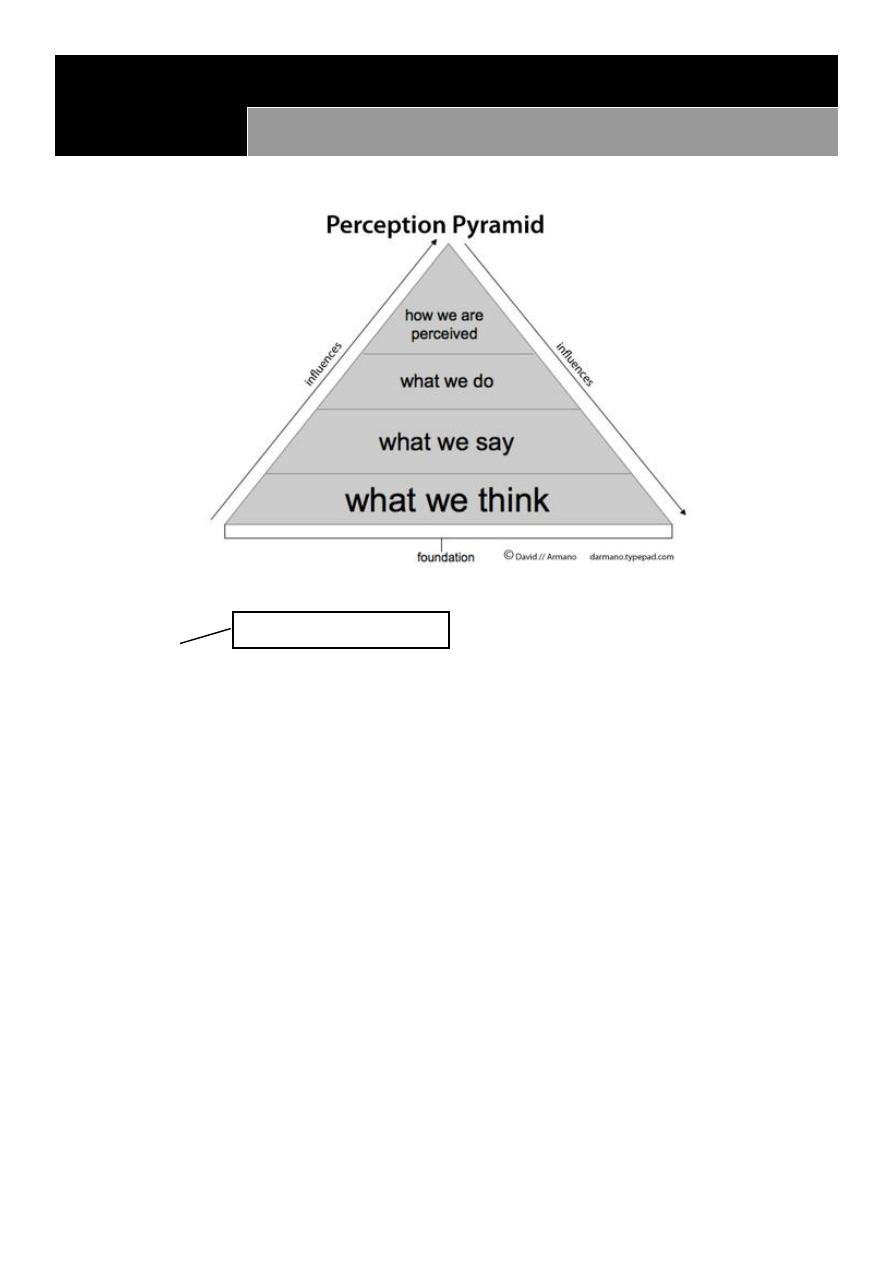
7
Lec:3
Psychology
Perception
Perception:
The conscious mental registration of a sensory stimulus
Recognition and interpretation of sensory stimuli based chiefly on memory.
The conscious recognition and interpretation of sensory stimuli that serve as a basis for
understanding, learning, and knowing or for motivating a particular action or reaction.
The result or product of the act of perceiving
Kinds of perception:
Depth perception, extrasensory perception, facial perception and stereo gnostic
perception.
Depth perception the ability to recognize depth or the relative distances to different
objects in space.
Extrasensory perception (ESP):
knowledge of, or response to, an external thought or objective event not achieved as the
result of stimulation of the sense organs
Important: definition

8
A. Telepathy or thought transference from one person to another.
B. Clairvoyance, visual perception of an object that is covered or sealed.
C. Precognition or perception of a future events.
Psycho kinesis (PK):
Manipulating object without touching them.
Process Perception:
Can be defined as the active process of selecting, organizing, and interpreting the
information brought to the brain by the senses.
How they work together:
Sensory organs absorb energy from a physical stimulus in the environment
Sensory receptors convert this energy into neural impulses and send them to the brain
perception follows
The brain organizes the information and translates it into something meaningful
But what does "meaningful" mean? How do we know what information is important and
should be focused on
Selective Attention - process of discriminating between what is important & is irrelevant
(Seems redundant: selective-attention?), and is influenced by motivation
ALL OF THIS IS CALLED Psychophysics
Psychophysics can be defined as, the study of how physical stimuli are translated into
psychological experience.
In order to measure these events, psychologists use THRESHOLDs
Threshold - a dividing line between what has detectable energy and what does not.
Difference Threshold - the minimum amount of stimulus intensity change needed to
produce a noticeable change.
The greater the intensity (ex., weight) of a stimulus, the greater the change needed to
produce a noticeable change
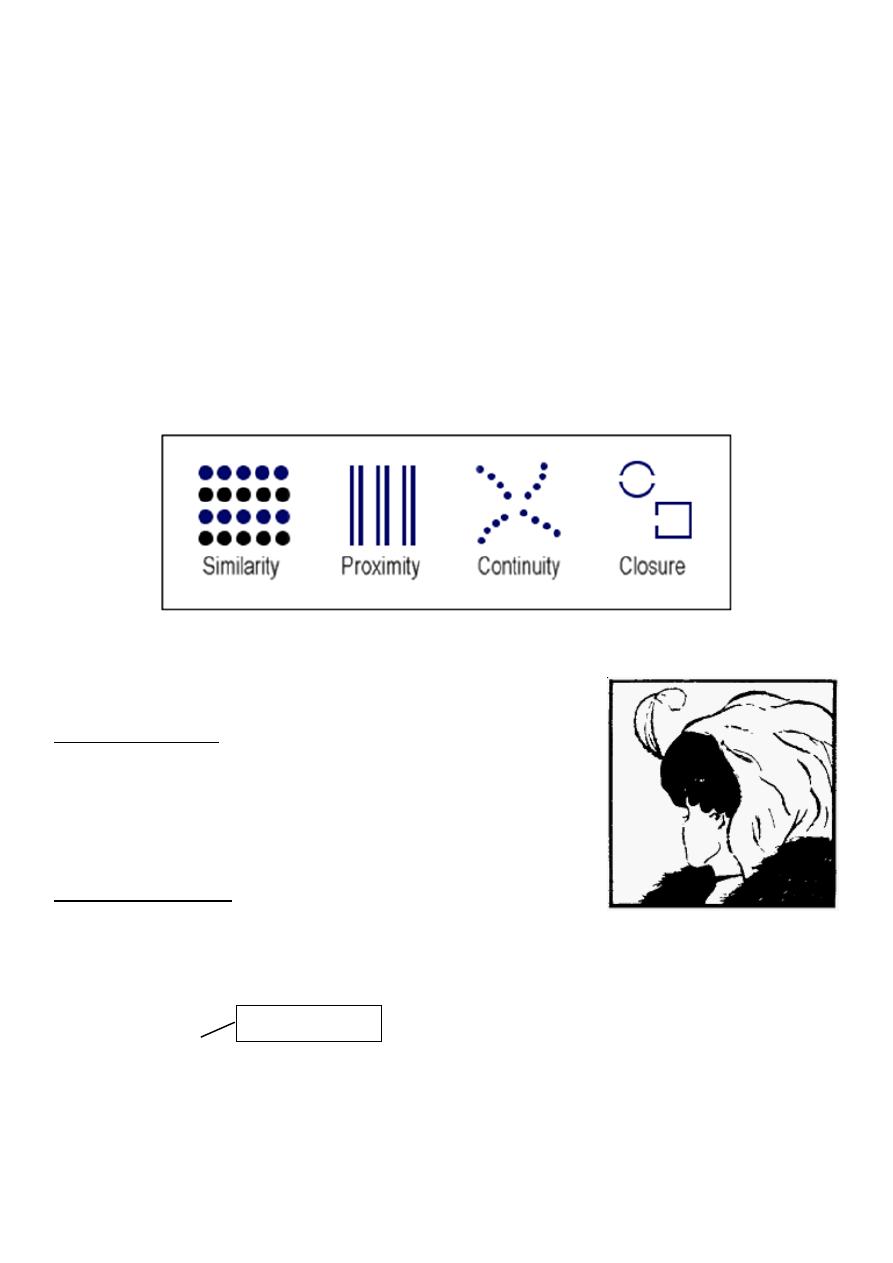
9
Signal detection theory:
The sensory ability of the observer
Selectivity of the observer
Expectancy & individual internal needs & interest
Fatigue and exhaustion
The urgency of the moment
Constancy of size shape and brightness
The Gestalt principles of grouping include four types: similarity, proximity, continuity, and
closure.
Disorder of perception:
I.sensory distortion
1. Changes in intensity (hyper acusis)
2. Change in quality (xanthopsia, erythropsia, chloropsia)
3. Change in special form (micropsia, macropsia)
II. Sensory deception
Hallucinations (imaginary perceptions). Hallucinations and illusions are often classed
together under the name of psych sensory disorders
Hallucination:
A perception, which feels real, but has no real stimulus usually abnormal, especially
when persistent.
But occasional hallucinations are more common than we thought! - 10% of British
population, at some time.
Important: all

11
Modalities:
o Auditory: heard as if coming from out with your head (including from another part
of the body) cf pseudohallucinations
o Visual (more indicative of organic pathology!)
o Olfactory
o Somatic / (visceral) / Sexual
o Gustatory
Non-pathological:
o Hypnagogic (going off to sleep)
o Hypnopompic (waking up)
Illusion:
Incorrect perception of a real stimulus (in any modality)
Is misperception or misinterpretation of external stimuli
Usually non-pathological
o Bush looks like a killer in the dark
o “cocktail party” illusion: hearing your name across a noisy room
o A stray hair may feel like a spider on the neck
BUT illusions occur in psychosis
o e.g. girl complains her face is melting when she looks in mirror
Insufficiency of Perception:
Insufficiency of perception in its slightest degree may be met with in states of depression,
at the onset of confusional states, etc. All external impressions are vague, uncertain, and
strange. The patients complain that everything has changed in them and around them:
objects and persons have no more their usual aspect; the sound of their own voice startles
them.
Finally, complete paralysis of one or several forms of psych sensory activity is observed in
connection with profound disorders of consciousness, as in mental confusion of the
stuporous form
Insufficiency of perception constitutes an important element of clouding of consciousness
Important: definition
Note:
Hallucination perception without presence of external stimulus in fully-conscious patient.
Illusion perception without presence of external stimulus in semi-conscious patient.
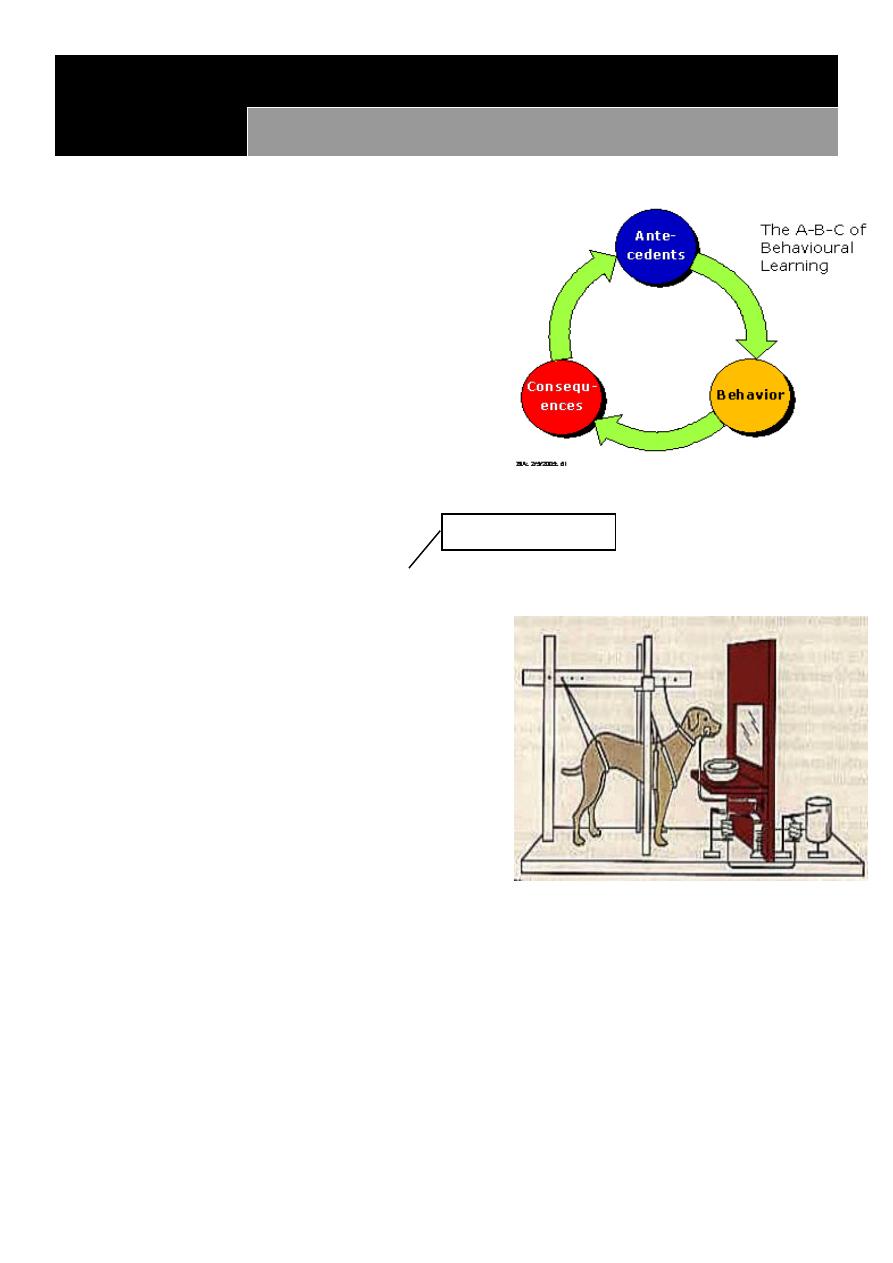
11
Lec:4
Psychology
Learning
Relatively permanent change in behavior as a result
of prior experience
Tasks used to study the phenomenon can be
grouped to 4-categories:
1. Classical conditioning
2. Operant conditioning
3. Multiple response Learning.
4. Cognitive learning.
A. Classical conditioning: Ivan PAVLOVs Experiment (Russian psychologist)
Pavlov studied the autonomic reflexes associated
with digestion, Pavlov noticed that noticed that a
dog salivated not just when the food was placed in
its, mouth but also to the mere sight of food.
Is the formation of association between a
conditioned stimulus & response through a
repeated presentation of the conditioned stimulus
in a controlled relationship with an unconditioned
stimulus that originally elicit the response.
Associative learning can be studied in conditioned response experiments.
Flow of saliva to food placed in mouth = unlearned response (unconditioned response)
Response to sight of food = learned response (conditioned response)
Pavlov taught the dog to salivate to various signals such as light tone, there by prove the
stimulus response association
Before conditioning:
CS (light) No response
Important: assay

12
U.S (Food) UR (salivation)
During conditioning:
US (food) UR (salivation) several trials
(few seconds)
After conditioning:
CS (Light) CR (salivation)
Law of classical conditioning:
1. Acquisition:
Each paired presentation CS&US =Trial
Period of learning=stage (vary)
Exp. Indicate that learning is fastest if the CS is presented about0.5 sec. before US.
The procedure for pairing the CS &US is called REINFORCEMENT
2. Extinction:
Repetition of the CS without reinforcement called extinction
3. Generalization:
Account for our ability to react to novel situation in so far as they are similar to familiar
ones
4. Discrimination:
Whereas generalization is a Reaction to similarities, Discriminations the reaction to
differences (Child using term Daddy for all men), child learn to discriminate cats, sounds
from Dogs sounds
Important: all
Note:
Positive reinforcement acquisition
Negative reinforcement extinction
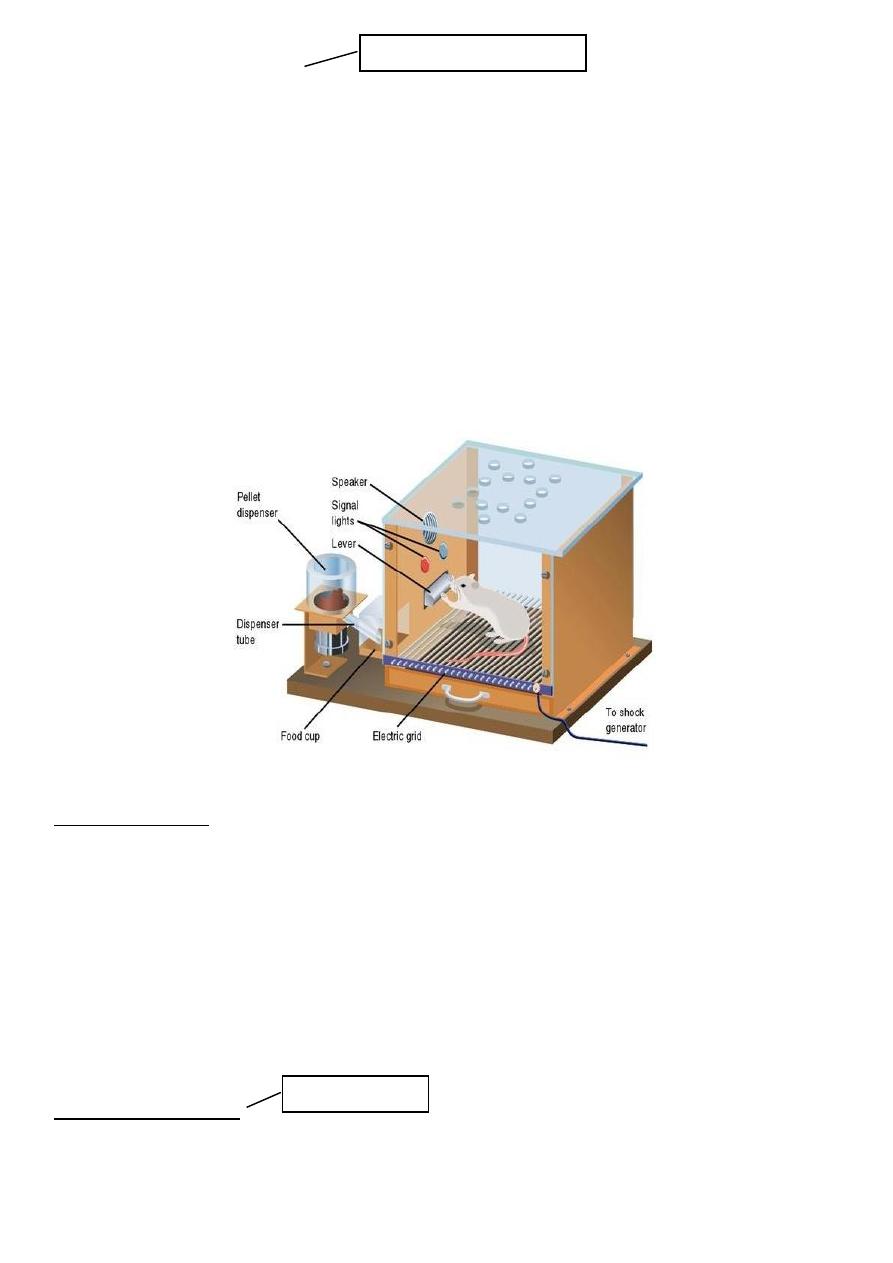
13
B. Operant conditioning:
Operant behavior = operate
(SKINNER)
The reinforced behavior bears no resemblances the behavior normally elicited by the
reinforcing stimulus e.g.
Ringing the bell = raising the bell
Light on pupil = constriction
In operant conditioning the animal is active. Skinners exp.is placing the rat in a box with a
bar, if pressed, food will be delivered, the more it press the more food will be delivered &
vise versa .Extinction happen if no food is available.
REINFORCEMENT:
Any event whose occurrence increases the probability that a stimulus will on a subsequent
occasions evoke a response.
Eg Positive (food, Negative (shock).
It is most important to reward or punish the organism immediately after it responds.
The reinforcement effect of stimulation in certain areas of the brain (primarily in the
hypothalamus) are powerful.
SHAPING of behavior:
Reinforces the only response that meet the experimenters specifications & extinguishing all
other e.g. (enuresis, shy, with drawn, stealing& all other conduct disorders
Important: all
Important: short notes

14
C. Multiple response learning:
e.g. Memorizing poem, athletic training , mirror drawing test …etc.
Learning that result from acquired pattern or sequence of behavior which involve more
than one identifiable act with the order of events usually fixed by the demand of the
situation.
D. Cognitive learning:
The learner form a cognitive structure in memory which preserve & organizes information
about the various events that occur in the learning situation
e.g insight experiment of Kohler on chimpanzee ( sultan ) ( Fruit , Sign learning
What lead to do what
Acquired expectation that one stimulus will be followed by other in a particular context. It
is classified as learning with understanding other than with conditioning e.g Chimpanzee,
(boxes, Fruit hanged from the roof).
Q: Which psychologist is famous for his pioneering work in classical conditioning?
A: B.F. Skinner
B: Sigmund Freud
C: John B. Watson
D: Ivan Pavlov
E: Robert Rescorla
Q: What is the name for the operant conditioning technique in which complicated
behaviors are taught by sequential reinforcement?
A: instructing
B: shaping
C: leading
E: modeling
D: scaffolding
Important: short notes
Important: short notes

15
Lec:5
Psychology
Intelligence
Definition
The ability to assimilate factual knowledge to recall either recent or remote events, reason
logically, to manipulate concepts, to translate the abstract to the literal to the abstract, to
analyze and synthesize forms , and to deal meaningfully and accurately with problems and
priorities in particular setting some psychologist describe many types of intelligence like
academic , musical , social ….. etc.
Or intelligence: is verbal ability, problems solving skills & the ability to adapt & learn from
lifes every day experiences.
The Intelligent quotient:
The intelligent (IQ) is the ratio of (MA) to CA (Chronological age multiplied by 100)
IQ=MA/C*100
An IQ of 100 or average result when chronological and mental age are equal.
Mental age (MA):
Is an individual level of mental development & intellectual level of particular age, relative to
others.
MA was firstly introduced by a French psychologist called AlferdBinet
Binet test:
L A scale consisted of 30 items ranging from the ability to touch ones nose or ear whem
asked to the ability to draw signs from memory & define abstract concepts the age of
children were 3-11 years
Mental retardation:
Is inadequate intellectual functioning in which the individual IQ usually below 70, has
difficulty adapting to everyday life & has onset of these characteristics during the
developmental period i.e by the age of 18
Important: all
Important: all
Important: all

16
Mild: 55-70 about 89% of mental retardation
Moderate: 40-54 6%
sever M.R: 25-30 3-5%
profound: below 25 1%
Giftedness:
Gifted have above average intelligence (I.Q 120 or higher)
Creativity:
Is the ability to think about something in usual ways & came up with unique solution to
problems thus intelligence & creativity are not the same thing
Some important facts about intelligence:
Many factors could contribute to the individual differences level but culture & ethnicity
& IQ test bias due to linguistic, economical & educational differences.
Mental ability tends to increase up to the age of 26, level off for the next 10 years , and
then decline after age 49 but recent research proved that IQ is increasing all over the
world due to positive environmental influences through stimulation & communication.
The most useful intelligence test must measure a variety of skills and abilities including
verbal – performance timed untimed culture free culture bound early learned late
learned,.
Test measure present functioning ability not necessarily of future potential
Intelligence tests:
Any type of test must be valid and reliable
Reliability:
Tell us whether test scores are consistent over times
Validity:
Tell us how well a test measures what is intended to measure
Important: all
Important: all
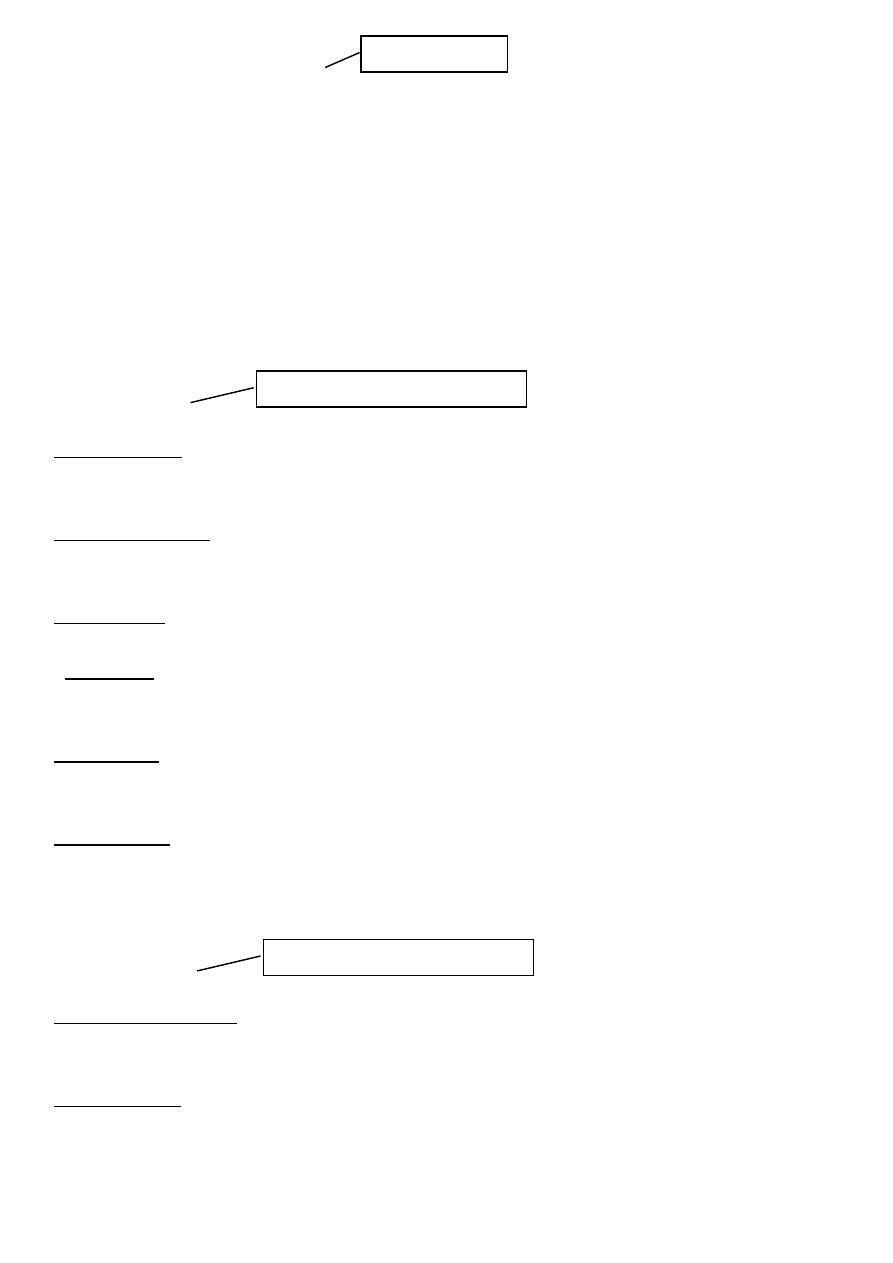
17
Wechsler intelligence test:
Constructed by David Wechsler at New York University in 1939 the original test gone
through several revisions the latest revision is lll
WAIS lll: is designed for person 16-89
WISC lll: (Wechsler intelligence scale years for children) designed for age 5-15
WPPSI-R:(Wechsler preschool and primary scale of intelligence - Revised) for children of 4-6
Construction of the test: WAIS comprises ll sub tests made up to six-verbal and 5
performance sub tests, for which there is verbal IQ.
Verbal skills:
1. Information: this sub tests covers general information and knowledge and is subject to
cultural variables. Persons from low socioeconomic groups with little schooling don't
perform as well as those from high socioeconomic groups with more schooling
2. Comprehension: this sub test measures subjects knowledge of social conventions and
common sense and examines qualities of person's reasons ought to behave under certain
circumstance
3. Arithmetic: the ability to do arithmetic and other simple calculations is reflected on this
sub test which is adversely influenced by anxiety and poor attention and concentration.
4. Similarity: This sub test is a sensitive indicator of intelligence it covers the ability to
abstract by asking subjects to explain the similarity between two things e.g.: in what ways
are the boat & the trains the same.
5. Digit span: immediate retention is measured in this sub test subject are asked to learn a
series of two to nine digits, which are immediately recalled both forward and backward,
anxiety, poor attention span , and brain dysfunction interfere with recall.
6. Vocabulary: subjects are asked to define 35 vocabulary words of increasing difficulty,
intelligence has a high correlation with vocabulary, which is related to level of education
idiosyncratic definitions of words may give clues to personality structures.
Performance:
1. Picture completion: this sub test initiates the performance part of the WAIS and consists
of completing a picture in which a part is missing visuo-perceptive defects become evident
when mistakes are made on this test
2. Block design: this sub tests requires subjects to match colored blocks and visual designs
brain dysfunction involving impairment of the left right dominance interferes with
performance e.g : an individual must assemble a set of multicolored blocks to match
designs that the examiner shows visual motor coordination , perceptual organization and
Important: all
Important: enumerate only
Important: enumerate only
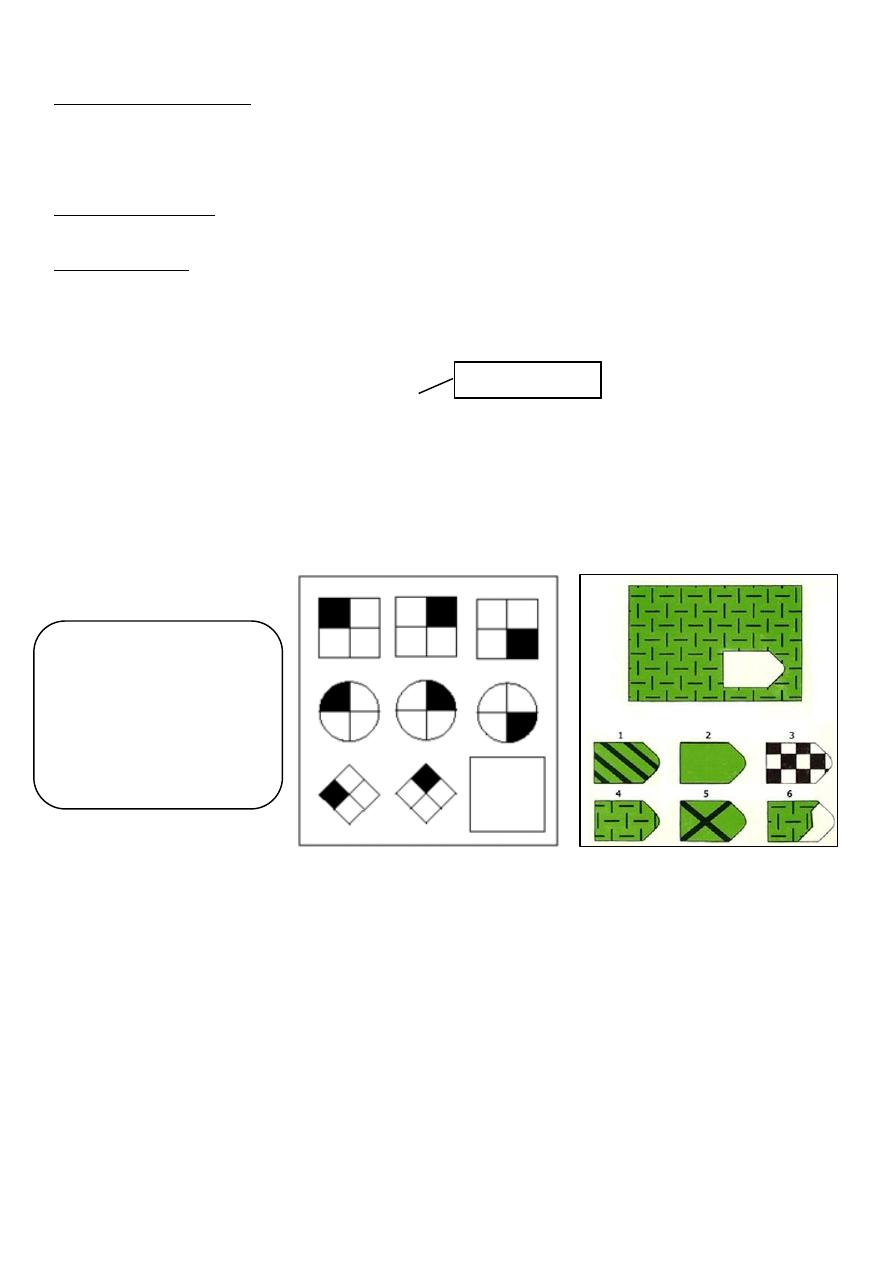
18
the ability to visualize spatially are assessed
3. Picture arrangement: subjects are require to arrange a series of pictures in a sequence
that tells a story ( e.g. a person committing a crime in addition to testing performance this
subtest provide data about a subjects cognitive style this sub scale evaluate how individuals
integrate information to make it logical and meaningful
4. Object assembly: subjects must assemble objects such as the figure of a women or an
animal in the proper order and organization visuo-perception.
5. Digit symbols: in this final subtest of the WAIS subjects receive a code that pair symbols
with digit the test consist of matching a series of digits to their corresponding symbols in as
little time as possible.
RAVEN Progressive Matrices IQ Test
Consist of 5 groups A,B,C,D,E each group consist 12 design of matrices in progressive
difficulties.
Each matrix contains a series of picture with a missing piece and the candidate has to select
the right answer from a number of correct answers and age
Other Tests
performance test
* Koh's block
The subject has to construct designs with the block according to given pattern of increasing
difficulty the result is usually expressed as mental age (MA) or IQ
* Domino Test
* Maze test
* Picture completion tests
Important: all
Note: RAVEN test:
Color test for less than
15 years
Black & white test for
adult
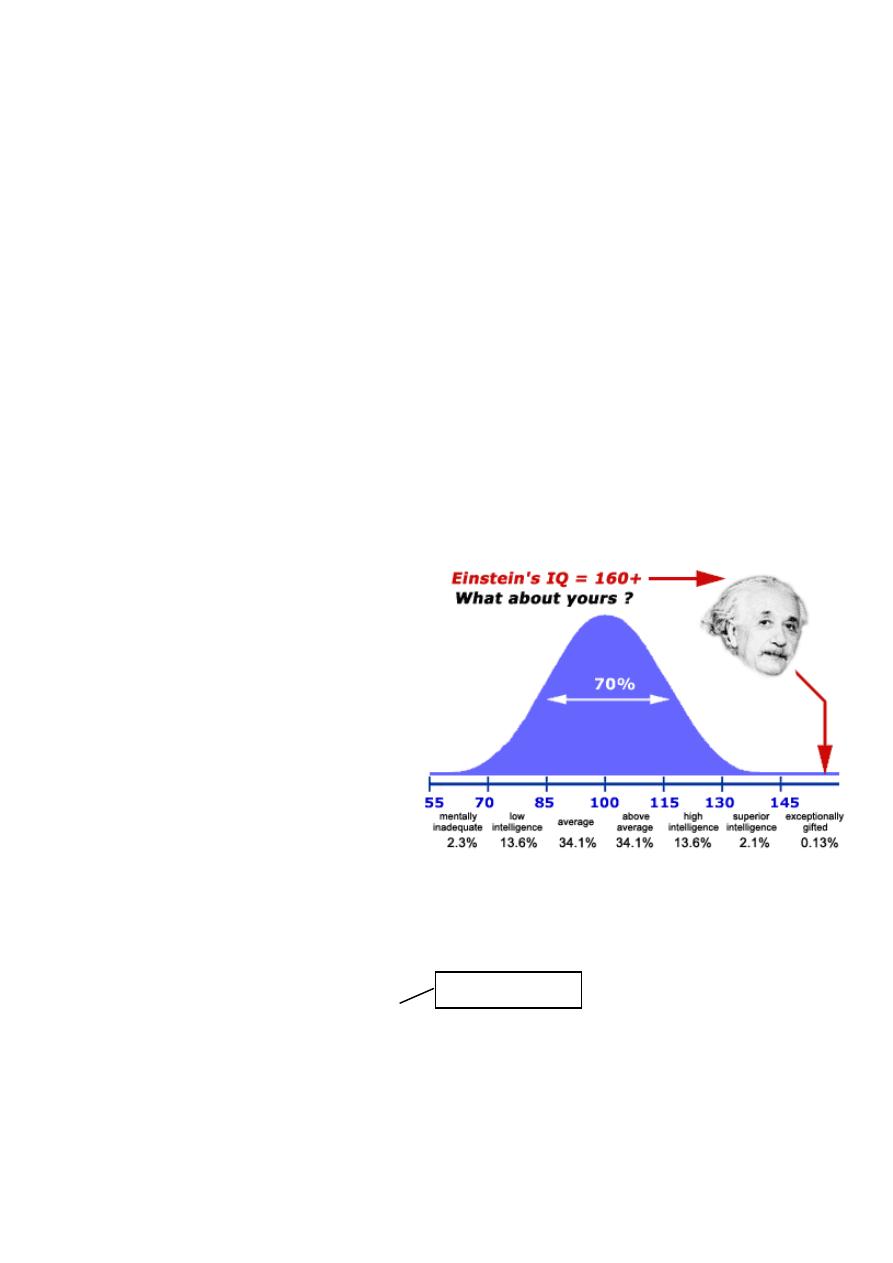
19
Advantage of performance tests
1. Can be used on illiterate, foreigners, deaf mute and those with speech difficulties.
2. Less determines by education than verbal tests
Disadvantages
1. Usually take a long time to do
2. The norms are different according to cultures.
Verbal tests:
Mostly consisting of series of short questions arranged in a progressive difficulties
according to mental ages there is a battery of question
*Binet test
* spearman approach
* Kent test
The extreme of intelligence are represented by: mentally subnormal at one end of the
scale, and the intellectually gifted at the other.
IQ Classification %
>129 very superior 1%
120-129 superior 11%
110-119 High average 18%
90-109 average 46%
80-89 low average 15%
70-79 borderline 6%
<70 mentally sub. 3%
(Subnormal: then IQ is below standard according to its severity, while mentally gifted IQ is
above standard and show superior attainment throughout childhood and adult life)
Practical uses of intelligence tests
1. Educational: * Selection of pupils for special groups: like schools classes or institutes
2. Researches: e.g. relationship between IQ and personality and behavior
3. Military service
4. Committees
* medical: (fitness for job or study)
* Courts and police (criminal responsibility)
Important: all

21
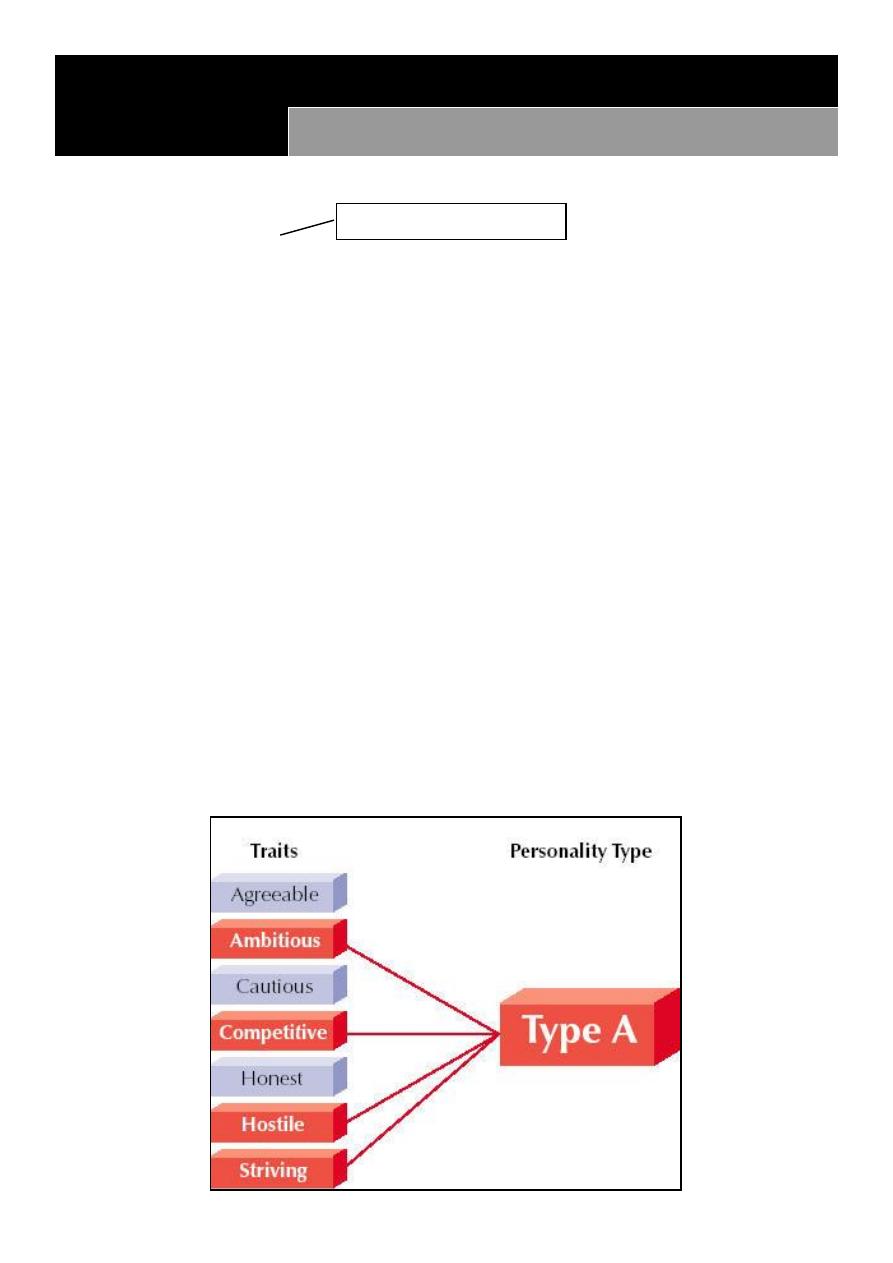
21
Lec:6-7
Psychology
Personality Development
Topics to Explore:
1. Trait Theories
2. Psychoanalytic Theory
3. Social-Cognitive Theories
4. Humanistic Theories
Some Terms:
1. Personality: a person’s internally based characteristic way of acting and thinking
2. Character: Personal characteristics that have been judged or evaluated
3. Temperament: Hereditary aspects of personality, including sensitivity, moods,
irritability, and distractibility
4. Personality Trait: Stable qualities that a person shows in most situations
5. Personality Type: People who have several traits in common
Example of Personality Type:
Important: enumerate

22
Personality Theory:
System of concepts, assumptions, ideas, and principles proposed to explain personality.
Types of Personality Theories:
Trait Theories: Attempt to learn what traits make up personality and how they relate to
actual behavior
Psychodynamic Theories: Focus on the inner workings of personality, especially internal
conflicts and struggles
Humanistic Theories: Focus on private, subjective experience and personal growth
Social-Cognitive Theories: Attribute difference in personality to socialization, expectations,
and mental processes
Jung’s Theory of Two Types:
Carl Jung, Swiss psychiatrist who was a Freudian disciple, believed that we are one of two
personality types:
Introvert: Shy, self-centered person whose attention is focused inward
Extrovert: Bold, outgoing person whose attention is directed outward
Eysenck’s Three Factor Theory:
Hans Eysenck, English psychologist, believed that there are three fundamental factors in
personality:
Introversion VS Extroversion
Emotionally Stable VS Unstable (neurotic)
Impulse Control VS Psychotic
The first two factors create 4 combinations, related to the four basic temperaments
recognized by ancient Greeks:
Melancholic (introverted + unstable): sad, gloomy
Choleric (extroverted + unstable): hot-tempered, irritable
Phlegmatic (introverted + stable): sluggish, calm
Sanguine (extroverted + stable): cheerful, hopeful
Important: only understand it
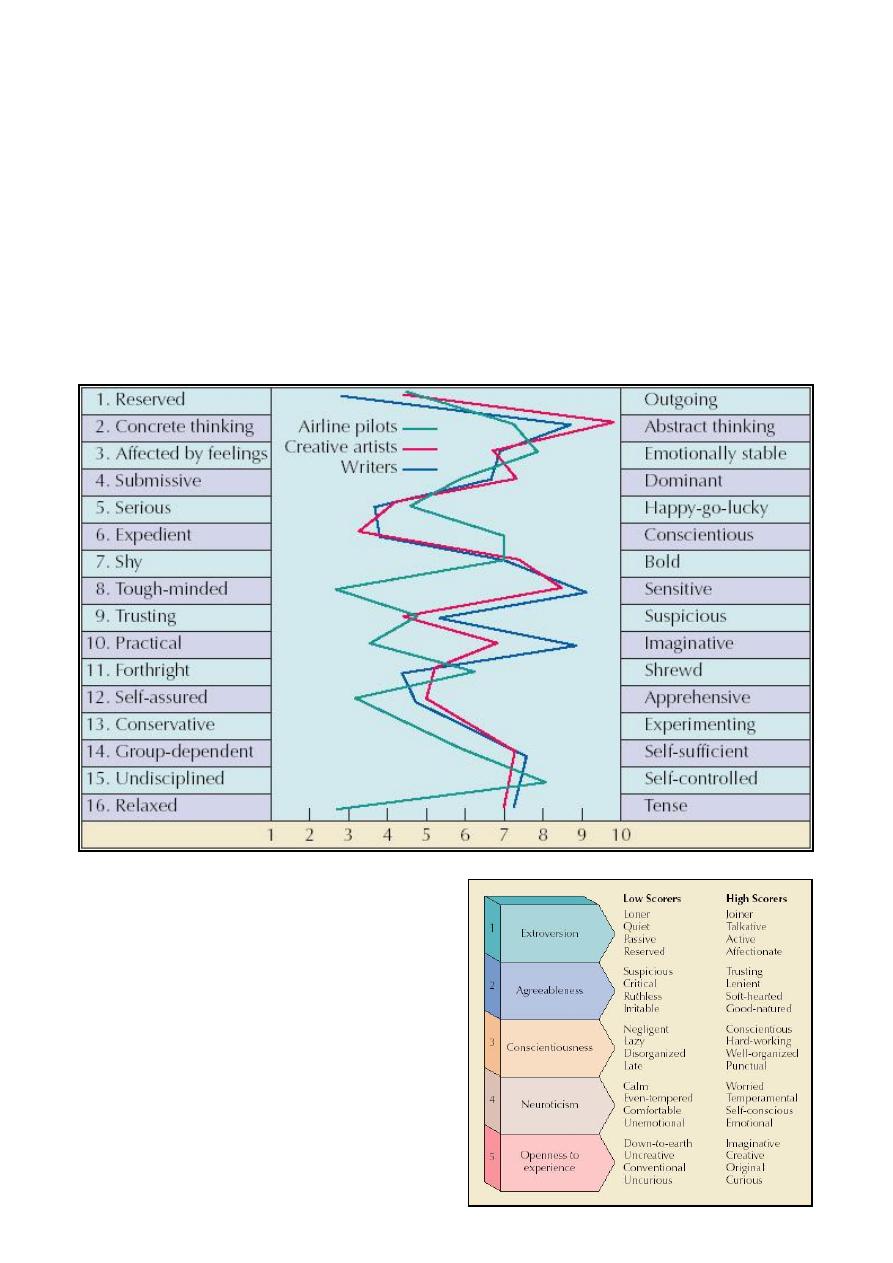
23
Cattell: Source & Surface Traits:
Raymond Cattell: from Devon, England, believed that there were two basic categories of
traits:
Surface Traits: Features that make up the visible areas of personality
Source Traits: Underlying characteristics of a personality
Cattell also constructed the 16PF, a personality test identifying 16 personality factors
(source traits).
The Sixteen Personality Factors:
Cattell: The Big Five:
Cattell believed that five factors were most
important:
Openness
Conscientiousness
Extraversion
Agreeable
Neuroticism

24
Evaluation of Trait Theories:
Are traits as pervasive as trait theories claim? Is someone shy always or does it depend
on the situation?
Are traits as enduring and unchangeable as trait theories claim? Can we change our
traits? If so, how easily?
Are traits affected by social and cultural upbringing? Or are our personalities formed at
birth and unchanging thereafter?
Part 2: Psychoanalytic Theory
Freud’s Psychoanalytic Theory
Sigmund Freud, M.D.,a Viennese physician who thought his patients’ problems were more
emotional than physical.
Freud began his work by using hypnosis and eventually switched to psychoanalysis.
Freud had many followers: Jung and Adler, to name a few.
More than 100 years later, his work is still influential and very controversial
The Id, Ego, and Superego:
Id: Innate biological instincts and urges; self-serving & irrational
Totally unconscious
Works on Pleasure Principle: Wishes to have its desires (pleasurable) satisfied NOW,
without waiting and regardless of the consequences
Ego: Executive; directs id energies
Partially conscious and partially unconscious
Works on Reality Principle: Delays action until it is practical and/or appropriate
Superego: Judge or censor for thoughts and actions of the ego
Superego comes from our parents or caregivers; guilt comes from the superego
Two parts:
o Conscience: Reflects actions for which a person has been punished (e.g., what we
shouldn’t do or be)
Important: all
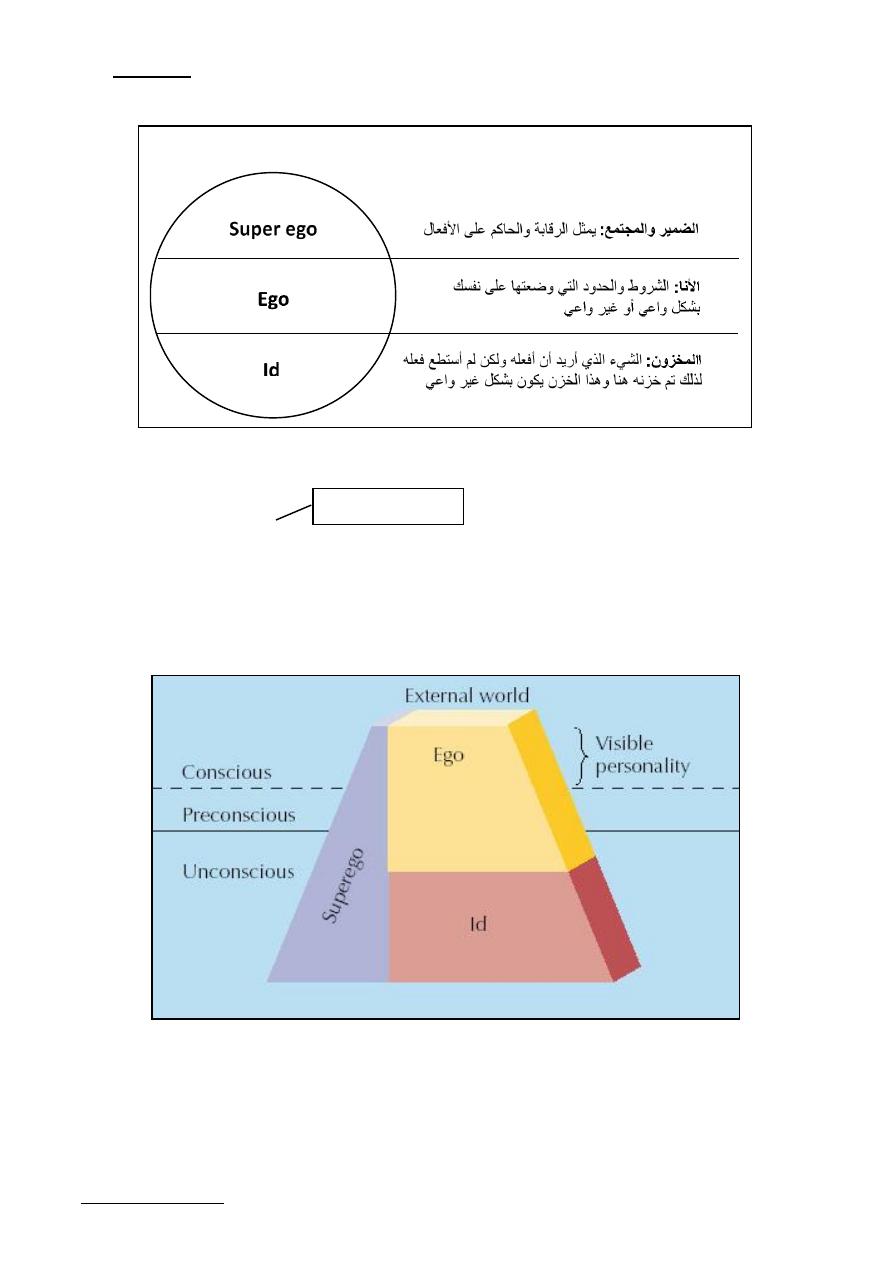
25
o Ego Ideal: Second part of the superego; reflects behavior one’s parents approved of
or rewarded (e.g., what we should do or be)
Levels of Awareness:
Conscious: Everything you are aware of at a given moment
Preconscious: Material that can easily be brought into awareness
Unconscious: Holds repressed memories and emotions and the id’s instinctual drives
Cause of Anxiety:
Ego is always caught in the middle of battles between superego’s desires for moral behavior
and the id’s desires for immediate gratification
o Neurotic Anxiety: Caused by id impulses that the ego can barely control
Important: all
Note:

26
o Moral Anxiety: Comes from threats of punishment from the superego
Defense mechanism: a process used by the ego to distort reality and protect a person from
anxiety
Examples of Defense Mechanisms:
o Regression: Ego seeks the security of an earlier developmental period in the face of
stress.
o Displacement: Ego shifts unacceptable feelings from one object to another, more
acceptable object.
o Sublimation: Ego replaces an unacceptable impulse with a socially acceptable one
o Reaction Formation: Ego transforms an unacceptable motive or feeling into its opposite.
o Projection: Ego attributes personal shortcomings, problems, and faults to others.
o Rationalization: Ego justifies an unacceptable motive by giving a false acceptable (but
false) reason for behavior
Personality Development:
According to Freud, personality develops in stages; everyone goes through same stages in
same order. Majority of personality is formed before age 6
Erogenous Zone: Area on body capable of producing pleasure
Fixation: Unresolved conflict or emotional hang-up caused by overindulgence or frustration
Stages of Personality Development:
Oral Stage: Ages 0-1. Most of infant’s pleasure comes from stimulation of the mouth. If a
child is overfed or frustrated, oral traits will develop.
o Oral Dependent Personality: Gullible, passive, and need lots of attention. Fixations
create oral-aggressive adults who like to argue and exploit others.
o Erogenous zone: mouth (oral)
Anal Stage: Ages 1-3. Attention turns to process of elimination. Child can gain approval or
express aggression by letting go or holding on. Ego develops. Harsh or lenient toilet training
can make a child either:
o Anal Retentive: Stubborn, stingy, orderly, and compulsively clean
o Anal Expulsive: Disorderly, messy, destructive, or cruel
o Erogenous zone: anus
Important: all
Important: all

27
Phallic Stage: Ages 3-6. Child now notices and is physically attracted to opposite sex parent.
Can lead to:
o Oedipus Conflict: For boys only. Boy feels rivalry with his father for his mother’s
affection. Boy may feel threatened by father (castration anxiety). To resolve, boy must
identify with his father (i.e., become more like him and adopt his heterosexual beliefs).
o Electra Conflict: Girl loves her father and competes with her mother. Girl identifies with
her mother more slowly because she already feels castrated.
Erogenous zone: phallus
Latency: Ages 6-Puberty. Psychosexual development is dormant. Same sex friendships and
play occur here.
Genital Stage: Puberty-on. Realization of full adult sexuality occurs here; sexual urges re-
awaken.
Evaluation of Psychoanalytic Theory:
Freud overemphasized sexuality and placed little emphasis on other aspects of the
child’s experience.
Freud’s theory is largely untestable. Particularly, the concept of the unconscious is
unprovable.
According to Freud, the only way that people in psychological distress can get relief is to
undergo length therapy, to identify unresolved conflicts from infancy and childhood.
Freud’s view of people is overly negative and pessimistic.
Part 3: Social-Cognitive Theories
Bandura’s Theory:
Self-system: the set of cognitive processes by which a person observes, evaluates, and
regulates his/her behavior. Bandura proposed that what we think of as personality is a
product of this self-system.
Children observe behavior of models (such as parents) in their social environment.
Particularly if they are reinforced, children will imitate these behaviors, incorporating them
into personality.
Bandura also proposed that people observe their own behavior and judge its effectiveness.
Self-efficacy: a judgment of one’s effectiveness in dealing with particular situations.

28
Rotter’s Theory of Locus of Control:
Julian Rotter: American psychologist, began as a Freudian! His personality theory
combines learning principles, modeling, cognition, and the effects of social relationships
External locus of control: perception that chance or external forces beyond personal
control determine one’s fate
Internal locus of control: perception that you control your own fate.
Learned Helplessness: a sense of hopelessness in which a person thinks that he/she is
unable to prevent aversive events
Evaluation of Social-Cognitive Theories
Social-cognitive theories tend to be overly-mechanical.
Overemphasizes environmental influences; gives little or no consideration to the
possibility of innate personality differences or the effects of genetics.
Does not recognize internal human qualities such as hope, aspiration, love, self-sacrifice
Part 4: Humanistic Theories
Humanism:
Humanism: Approach that focuses on human experience, problems, potentials, and
ideals
Human Nature: Traits, qualities, potentials, and behavior patterns most characteristic of
humans
Free Choice: Ability to choose that is NOT controlled by genetics, learning, or
unconscious forces
Subjective Experience: Private perceptions of reality
Maslow’s Theory:
Abraham Maslow is considered father of the humanistic movement. He observed the
lives of (purportedly) healthy and creative people to develop is theory.
Hierarchy of needs: the motivational component of Maslow’s theory, in which our
innate needs, which motivate our actions, are hierarchically arranged.
Self-actualization: the fullest realization of a person’s potential
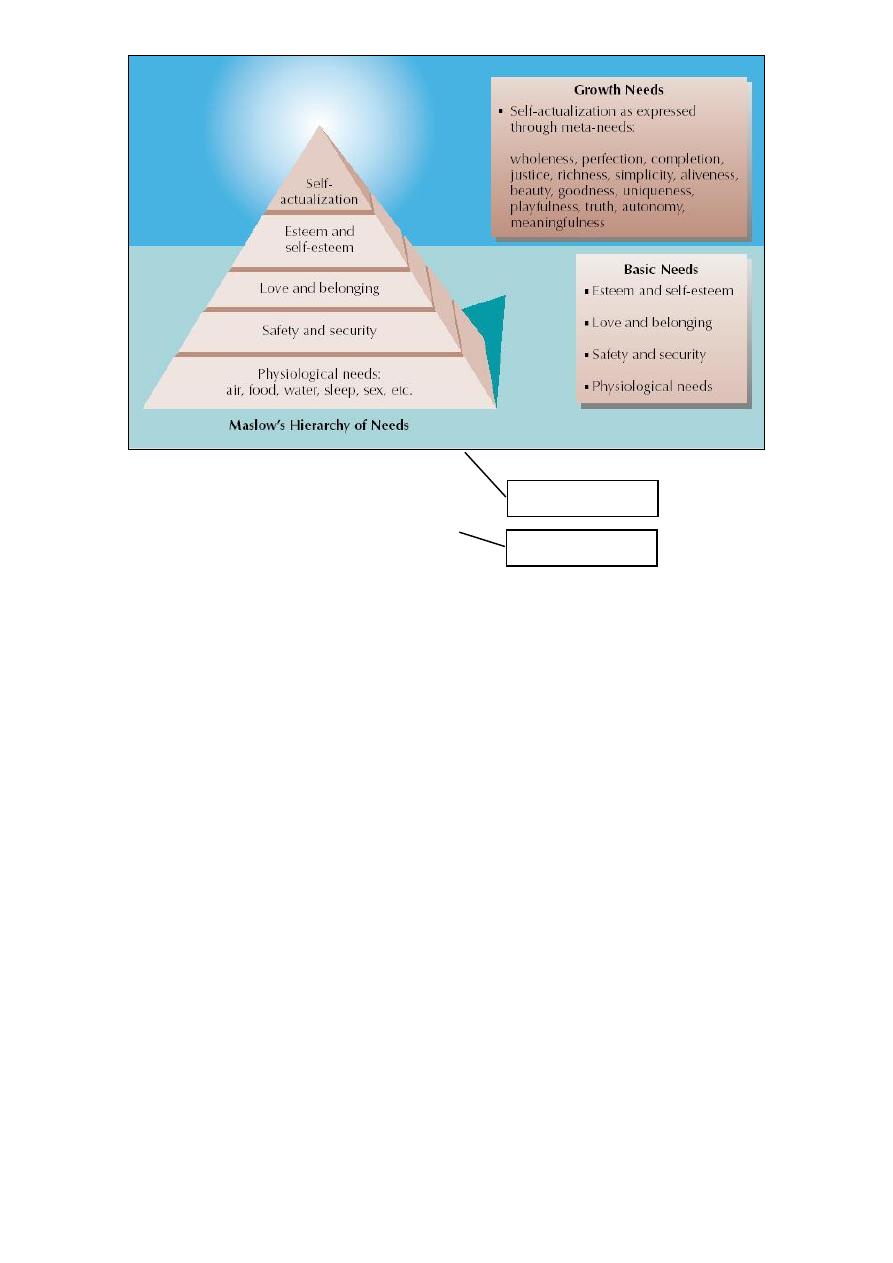
29
Characteristics of Self-Actualized People
Efficient perceptions of reality
Comfortable acceptance of self, others, and nature
Spontaneity
Task Centering
Autonomy
Continued freshness of appreciation
Fellowship with humanity
Profound interpersonal relationships
Comfort with solitude
Non-hostile sense of humor
Peak experiences
Some Self-Actualized People
Albert Einstein
Ralph Waldo Emerson
William James
Thomas Jefferson
Abraham Lincoln
Eleanor Roosevelt
Albert Schweitzer
Mahatma Gandhi
Important: all
Important: all

31
Carl Roger’s Self Theory:
Carl Rogers: American psychologist; believed that personality formed as a result of our
strivings to reach our full human potential.
Fully Functioning Person: Lives in harmony with his/her deepest feelings and impulses
Self-Image: Total subjective perception of your body and personality
Conditions of Worth: behaviors and attitudes for which other people, starting with our
parents, will give us positive regard.
Unconditional Positive Regard: Unshakable love and approval
Positive Self-Regard: Thinking of oneself as a good, lovable, worthwhile person
Evaluation of Humanistic Theories:
Many of the Humanists’ claims are untestable.
Humanists may have an overly-positive, rosy view of humankind. They do not look at
the “dark side.”
For the Humanists, the cause of all our problems lies not in ourselves, but in others.
Maslow’s characterization of self-actualized individuals is very biased toward a certain
philosophical position.
Most of the people Maslow identified as self-actualized had rather serious psychological
problems.
Interpreting the Briggs-Myer
o Extraversion: sociability, energized by people, lonely when alone (75%)
o Sensation: practical, trusts facts; learns through ex-perience; wants to deal with what’s
real
o Thinking: prefers the objective, logical, analytical
o Judging: prefers closure, wants deadlines, feels more comfortable once a decision has
been made.
o Intraversion: territorial, enjoys being alone, private, drained by people (25%)
o Intuition: innovative, fantasizes; future more attractive than the present
o Feeling: prefers the subjective, personal, values
o Perceiving: resists closure, wants more & more data; values the open-ended; pressure
to decide stressful

31
Lec:8
Psychology
Life cycle
Growth and Development
The organism exposed to:
1. Biological factor
2. Environmental factor
A- How do biological factors interact with the events in the child environmental to
determine the course of development (often called nature-nurture ) question?
B- Is development best understood as a general continuous process of change or as a series
of abrupt distinct stages?
Today most psychologists agree not only that both nature and nurture play important role
but that they interact continuously to guid development for ex. The development of many
personality trait.
Such as sociability and Emotional stability and psychiatric illnesses can have both genetic
and environmental factors.
For ex. The human fetus develops within the mother body according to fixed time
schedules and fetal behavior such as turning, kicking also follows an orderly sequence that
depends on the stage of growth if the uterine environment is seriously abnormal in some
way maturational processes can be disrupted
For ex. If the mother contacts German measles during 1
st
3 months of pregnancy (when the
fetus basic organ systems are developing according to a genetically programmed schedules
the infant may be born deaf.
Blined or brain damage depending on which organ system was in a critical stage of
development at the time of infection.
Maternal malnutrition, smoking and consumption of alcohol and drugs are among other
environmental factors that can affect the normal maturation of the fetus.

32
Stages of development:
The life span, is being divided into stages:
1- Infancy 2- Childhood 3- Adolescent 4-Adulthood
The concept of these stages are:
1. The behavior at a given stage is characterized for that stage only.
2. The behavior at a given stage differ from behavior at earlier or later stages.
3. All children go through the same stages in the same order.
Capacities of the newborn:
The newborn infant inter the world with all sensory systems functioning and are well
prepared to learn about their new environment , the basic method is to introduce some
change in the baby environment and observe his responses
Ex. Like high tone, or flashing light and see if there is changes in the heart rate of the baby
or turning head.
Stages of motor development:
In the 1
st
3 months the baby roll over
-4.5 months ----bear some weight on legs.
Months ----sit without support.
o 6 months ---- stand holding furniture.
o 9 months ----- walk holding.
o 11.5 months ----- standalone well.
o 12 months ----- walk alone
Factors affecting growth
Perception of stimuli through his sensory system.
Pattern of thinking. طريقة التفكير
Motive (desire )
الدافع او الحافز
Emotion
االنفعال
Conflicts
الصراعات
.النفسية
Way of coping with the conflict
Important: all
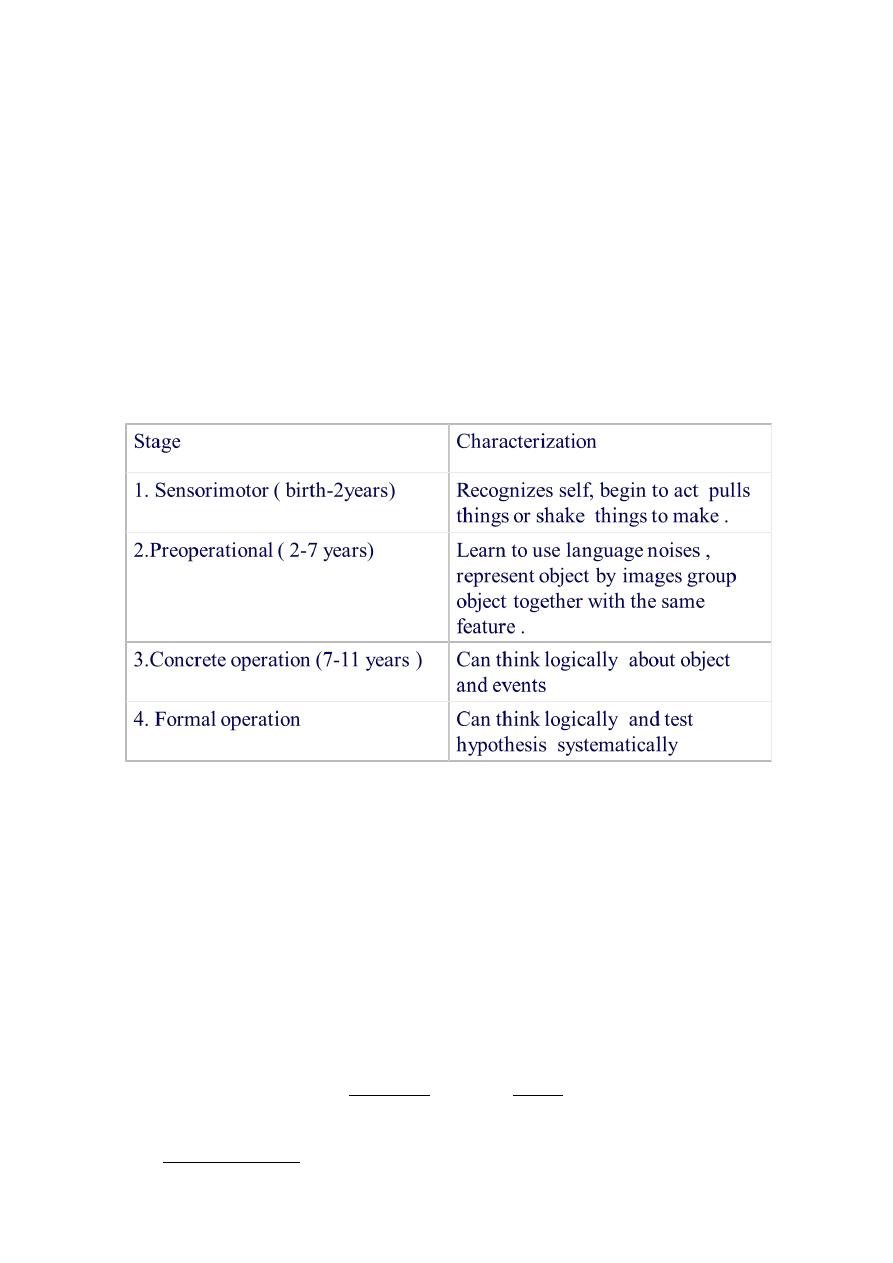
33
Factors affecting behavior:
Maturation – this is an innate process, it is controlled by physical changes, it does not
depend on environment events.
Environment factors:
o Deprivation الحرمان
o Enriched environment.
Culture – child exposed to different conditions in the stages of their critical period during
its growth the child very sensitive to stimulation over or under stimulation of the child is
harmful ex. To let the child to walk or speack early.
Cognitive development in childhood piage’s stages of cognitive development
The ages given are averages, they may vary considerably depending on the intelligence,
cultural background and socioeconomic factors, it is for all children.
نؤكد على اهمية وتاثير اسلوب التعامل السليم مع الطفل في مراحل نموه سالفة الذكر كلها وضرورة ادامة العالقة
له ( االبوين او غيرهما ) واالعتدال في االهتمام به وعدم االفراط بالقلق عليه الودية بينه وبين مقدمي الرعاية
واالستجابة الودية الحتياجاته االساسية
ورغباته المشروعة واالبتعاد عن العنف في تربيته والتصرف كقدوة حسنة
. صادقة امامه . كل ذلك سؤدي الى نمو نفسي سليم ويحصنه ضد االضطراب النفسي مستقبال
Personality and social development
Early social behavior by the age of 2 months the child smile at face of mother or father.
Infant all over the world begin to smile at about the same age which indicate that
smiling is an innate response ( instinctive response . ) غريزة

34
At about 8 months to the end of one year infant shows some anxiety about facing
strangers. Memory development appear to involve in separation anxiety.
Child 2-3 years can use language to communicate their want and feeling.
3-4 years child can think in a symbolic terms their words and images are not yet organized
in a logical manner piage calls 2-7 years stage of cognitive development preoperational
because the child cannot yet comprehend certain rules or operations in combing or
separating information in a logical manner.
o Attachment: - the infant tendency to seek closeness to particular people and to feel
more secure about thier presence is called attachment these early responses to the
mother have a clear adaptive value they prevent the organism from wandering away
from the source of care and getting lost. Baby’s attachment has been found to
remain stable when retested in the strong situation several years later unless the
family have a major changes in their life.
o Social learning theory:
Children receive for ex. appropriate and inappropriate behavior respectively and the
way in which children learn sex typed behavior through their observation of adult.
Social learning theory based on observational learning rather than on inner theory.
o Cognitive developmental theory
Gender identity itself develops slowly over the years from 2-7 according to the stage
of development a person sex remain the same despite changes in age and
appearance is called Gender constancy جنس
The studies showed that 3-4 and early 5 years old children showed gender constancy.
Development after childhood
the psychoanalyst proposed a series of 8 stages to characterized development throughout
life, they call them psychological stages because he belived that the psychological
development of an indivual depend on social relation at each stage, there are special
problem or crises to be faced.
o Adolescence:
adolescence refer to the period of transition from childhood to adulthood , its age
limits are not clearly specified , it extend from 12 months to late tens when physical
growth nearly complete , during this period the young person develops sexual
maturity and establishes an identity as an individual a part from the family.

35
o Sexual maturity:
Puperty the period of sexual maturation that transform a child into a biological
mature adult capable of sexually reproduction take place over a period 3 or 4 years.
The data indicate that puperty have significant effect on body image, selfestem,
mood and relationship with member of opposite sex.
o A major task confronting the adolescent is to develop the sense of identity or self-
definition it is an integral part of psychosocial development.
o Early adulthood:
During the early adult years people search for an occupation and many marry or
form relationship with other and this done through the identity.
o Middle adulthood:
The middle age 40-65 years are the most productive period, middle age is often a
time of transition as people reache the mid-point in life, they tend to look at years
left to live.
o The Aging years:
People over 65 years now composed 12% of the population normal aging is a gradual
process that bring some changes like slower reflexes.
Weak eyesight and hearing, but the more extreme disabilities are the result of diseases
such as Alzheimer’s which distrongs mental and physical functioning. Old age is a time
looking back on the events of a life time to the extent that the individual has successful
cope with the problems.

36
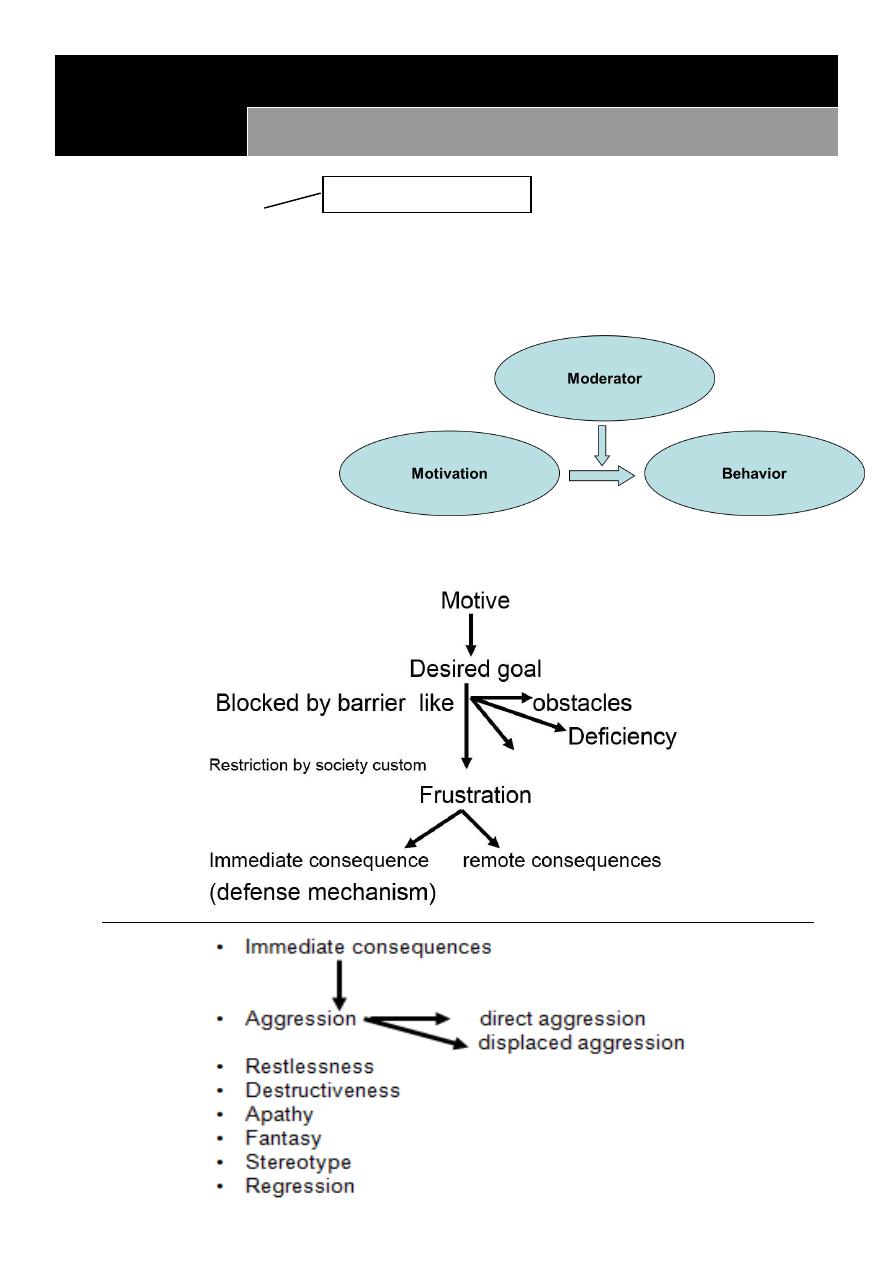
37
Lec:9
Psychology
Motivation
What is motivation?
Coming from the Greek word “movere” which means to move, motivation involves the
question of why people behave, think and feel the way they do.
Motivational Moderators
Influence the impact of
motivation on behavior
Important: definition

38
What is motivation?
Motivation is having the desire and willingness to do something (e.g. becoming a
professional; learning how to ride a bike)
What are the characteristics of a motivated behavior?
Energized to do or engage in an activity.
Directed towards reaching a specific goal.
Sustained and intensified feelings about reaching that goal.
What are the kinds of motives?
Basic or Primary Motives
1. Need to adjust to temperature
2. Need to quench thirst
3. Need to satisfy hunger
4. Avoidance of pain
5. Need for sensory stimulation
6. Need for sex
Acquired or Secondary
1. Need to belong
2. Need for love
3. Need for achievement
4. Need to be nurtured
5. Need for safety
Theories of Motivation
The Biological Influences
I. INSTINCT THEORY
William McDougall (1908): Humans are motivated by a number of different instincts
(e.g. curiosity, self-assertion).
Instincts—are innate tendencies or biological forces that determine behavior; they are
assumed to be universal throughout species.
Important: all
Important: all
Important:
Enumerate
Definitions

39
Instincts are now redefined as fixed action pattern—an innate biological force that
predisposes an organism to behave in a fixed way in the presence of a specific
environmental condition
II. DRIVE-REDUCTION THEORY
Key Components:
Need—a biological state in which the organism lacks something essential for survival
(e.g. food, water, oxygen); a deprivation that energizes the drive to eliminate or reduce
the deprivation.
Drive—a state of tension produced by need that motivates the organism to act to
reduce that tension.
Why would the organism want to reduce the tension? To go back to a state of
homeostasis—once the need is satisfied, the body returns to a more balanced state or
equilibrium.
DRIVE-REDUCTION THEORY: A need results in a drive, which is a state of tension that
motivates the organism to act to reduce the tension and return the body to
homeostasis.
The Behavioral and Socio-Cultural Influences
III. INCENTIVE THEORY
Incentives—are environmental factors, such as external stimuli, reinforcers or rewards
that motivate our behavior.
Examples: grades, recognition, money, fame
Because incentives are external, they are thought of as pulling us to obtain them;
whereas drives are internal, they are thought of as pushing us to obtain them. Hence,
incentives and drives are the pull and push of our behavior.
The Cognitive Influences
IV. COGNITIVE THEORY
Extrinsic motivation—involves engaging in certain behaviors or activities because of
incentives or external rewards
Intrinsic motivation—involves engaging in certain behaviors or activities because the
behaviors themselves are personally rewarding or because engaging in these activities
fulfills our beliefs or expectations.
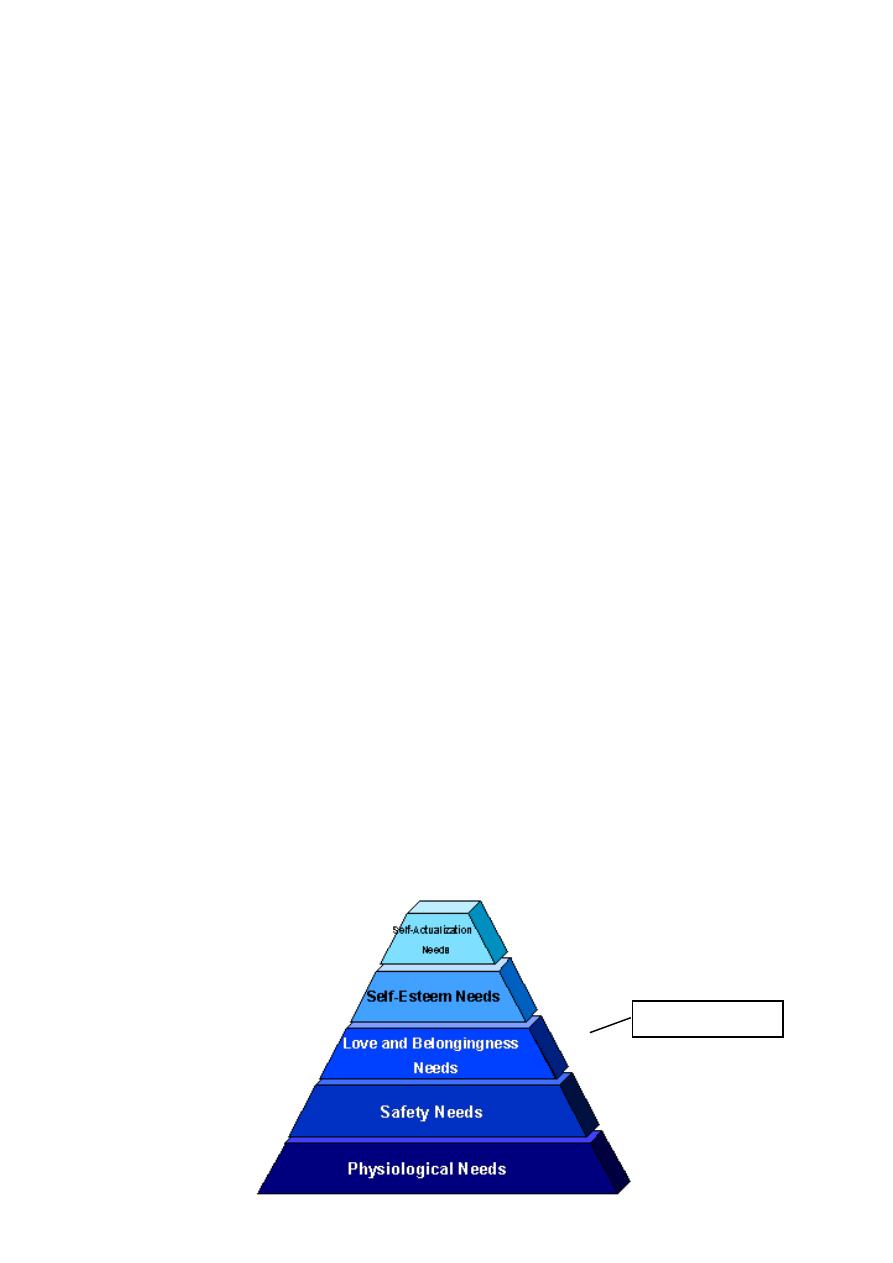
41
In summary:
The theory of fixed action patterns (instinct) explains the behavior of animals.
The drive-reduction theory (a pushing forced) explains our actions to meet biological or
physiological needs.
The incentive theory (a pulling force) explains why we do things to obtain external
rewards.
The cognitive theory explains that we do things to satisfy personal beliefs or meet
personal goals.
The Humanistic Approach
Maslow’s Hierarchy of Needs:
Abraham Maslow believed that our needs are arranged in a hierarchy.
We satisfy our biological needs first before we turn our attention and energy to fulfilling
personal and social needs.
Maslow’s hierarchy of needs is represented by a pyramid and shows the order in
satisfying biological and social needs.
Two Kinds of Needs:
Biological needs—are physiological requirements that are critical to our survival and
physical well-being.
Examples: food, water, oxygen, sleep, avoidance of pain and sex
Social needs—are needs that are acquired through learning and experience.
Examples: affiliation, nurturance, play, dominance, achievement
Important: all
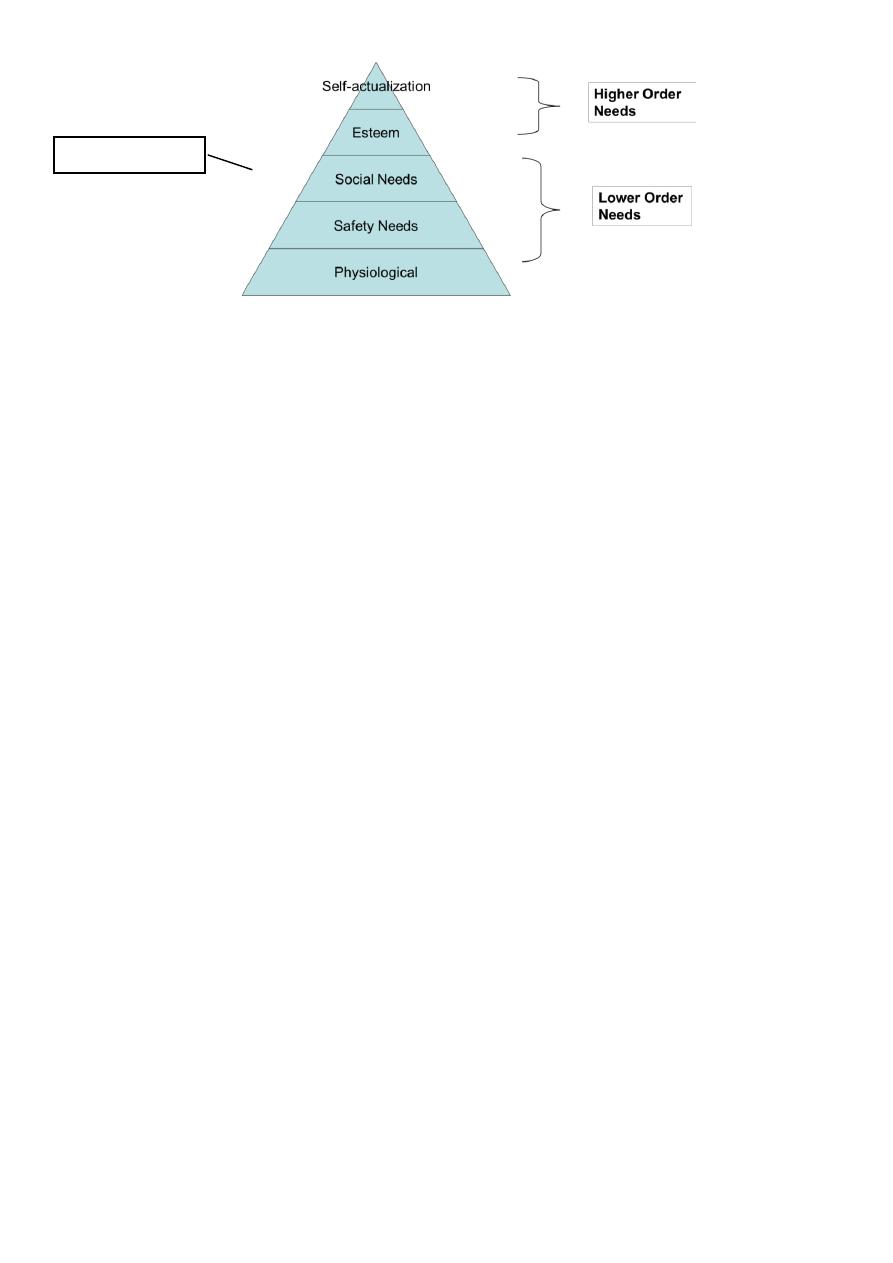
41
Level 1. Physiological needs
Physiological needs—includes food, water, sleep, sex, etc. necessary for basic survival.
Examples: People who are homeless would be especially concerned with satisfying their
physiological needs.
Level 2. Safety and security needs
Safety and security needs—the need for protection from harm.
Examples: People who live in dangerous communities will be concerned about satisfying
their safety needs.
Level 3. Love and belongingness needs
Love and belongingness needs—the need for affiliation and acceptance by others.
Examples: Adolescents and young adults who are beginning to form serious
relationships would be interested in satisfying their need for love and belongingness.
Level 4. Esteem needs
Esteem needs—the need for achievement, competency, gaining approval and
recognition.
Examples: During early and middle adulthood, people are concerned with achieving
their goals and establishing their careers.
Level 5. Self-actualization needs
Self-actualization needs—the need to fulfill one’s unique potential as a human being;
this is the highest and most elusive kind of need and because it is difficult and
challenging, only a few individuals are able to reach this level.
Important: all

42
REFLECTION: What motivates me most?
• Write a short reflection paper on the things that motivate you most:
– To achieve
– To love
– To go on with your life
• Rank the following list of values in terms of how important are they as your guiding
principles :
– A comfortable life
—An exciting life
– A sense of accomplishment
—A world at peace
– A world of beauty
—Equality
– Family security
—Freedom
– Happiness
—Inner harmony
– Mature love
—National security
– Pleasure
—Salvation
– Self-respect
—Social recognition
– True friendship
—Wisdom

43
Lec:10
Psychology
Aggression
Objectives:
1. Definition
2. Psychpathology of aggression
3. Theories of aggression
Definition:
Aggression A form of behavior characterized by physical or verbal attack. Aggression
may be directed outward, against others, or inward, against the self, leading to self-
destructive or suicidal actions. It may be driven by emotional arousal, often some form of
frustration, or it may be instrumental, when it is used to secure a reward.
Sigmund Freud :
Postulated that all humans possessed an aggressive drive from birth, which, together
with the sexual drive, contributed to personality development, and found expression in
behavior
Suggested that aggression was innate, an inherited fighting instinct, as significant in
humans as it was in other animals. Many psychoanalysts have argued against these
theories, which see aggression as a primary drive, offering the possibility that aggression
may be a reaction to frustration of primary needs.
Albert Bandura:
More recently, Albert Bandura has performed studies: indicated that aggression is a
learned behavior. Using children in his studies, Bandura demonstrated that, by watching
another person act aggressively and obtain desirable rewards or by learning through
personal experience that such behavior yields rewards, aggression can be learned.
Leonard Berkowitz:
. A number of psychologists: Anonymity may facilitate aggression: when an individual is
part of a large group, he may be more likely to elicit aggressive behavior, in a process
known as deindividuation.
Important: all

44
Children and adolescents are vulnerable to media portrayals of violence, particularly in
film and television. Popular media tends to depict violence as relatively common, and
generally effective.
Biological basis:
Recent research on the biological basis aggression has sought to show that genetic
factors may be responsible for aggressive behavior.
In the 1970s it was suggested that men who were born with an extra Y chromosome
were likely to display more episodes of aggressive behavior than men who were not
born with this extra chromosome. Still, conclusive proof has yet to be found for a
genetic theory of aggression.of
Other factors:
Including learning difficulties, minimal brain damage, brain abnormalities—such as
temporal lobe epilepsy.
And such social factors as crowding and poverty have been suggested to have
contributed in certain cases to exaggeratedly aggressive behavior.
Psychological investigation into aggressive behavior continues, with significant corrolary
studies being performed in endocrinology—to determine whether hormonal imbalances
have an impact on behavior—and in primate research. Each theory may be accurate in
part, since aggression is believed to have a number of determining factors.
Theories of Aggression:
Psychodynamic view:
o Emphasises the innate/instinctual aspect of aggression
o Triggers include anger, frustration, shame
Evolutionary view:
o All animals display the capacity to harm or kill other members of their species
o Aggression: strategy evoked when survival or reproductive success is threatened
Cognitive neoassociation theory: Exposure to aversive stimuli trigger aggressive
thoughts and actions.
Cognitive-social perspective: Aggression results from reward, punishment, cognitive
processes and social learning
General aggression model: Person and situation variables combine to determine the
presence of aggression
Important: enumerate only
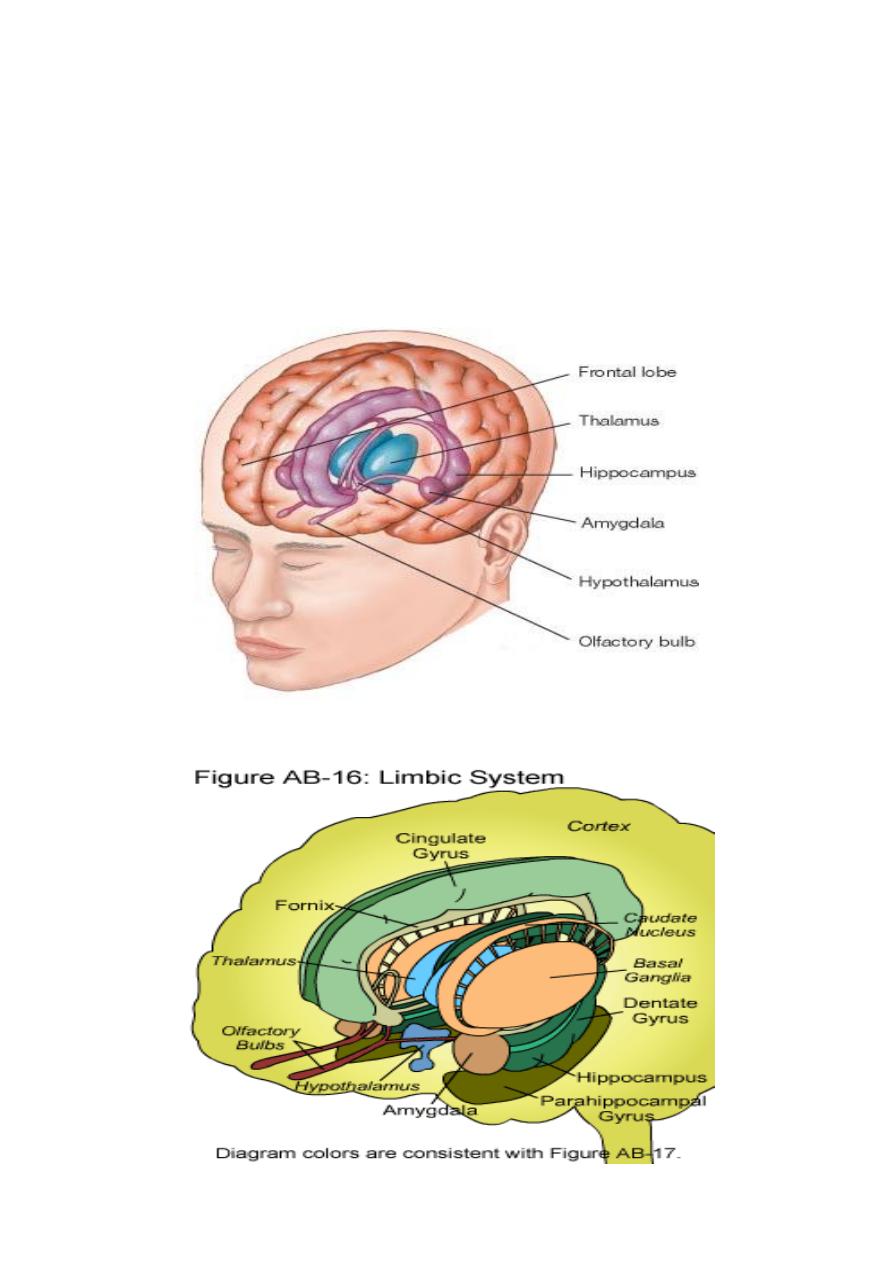
45
The Biology of Aggression
Aggression is controlled by the brain
Can be evoked by electrical stimulation of the hypothalamus and the amygdala
Lesions of the amygdala produce a tame animal
Aggression is modulated by hormones testosterone and serotonin
Genetics: Animal studies reveal that an aggressive temperament can be inherited

46
Person Perception
• Person perception is the process of forming impressions of others.
• Perceptions of others can be influenced by a variety of factors, including physical
appearance. People tend to attribute desirable characteristics such as sociable, friendly,
poised, warm, competent, and well-adjusted to those who are good looking. People use
social schemas, organized clusters of ideas about categories of social events and people,
to categorize people into types.
